Geraldine
Farrar
.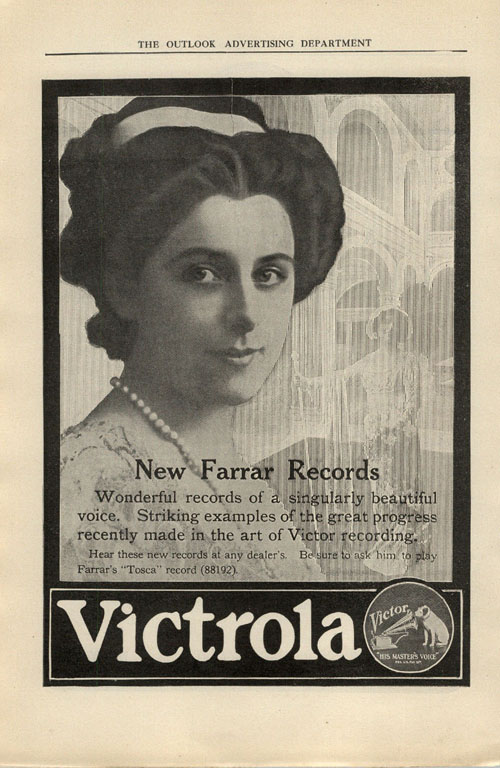
Recording Artist
and Willa Cather Prototype
By Doug Boilesen, 2020
Geraldine Farrar has been identified
by scholars (1) as one of the prototypes
for Kitty Ayrshire used by Cather in her opera related stories Scandal
and A Gold Slipper.
Besides starring on the opera stage
Farrar made phonograph records and was featured in advertisements
which added her celebrity status, artistic reputation, and the prestige
of opera to the promotion of the early phonograph.
This gallery provides examples of Geraldine
Farrar in her popular culture roles as seen in advertisements, postcards
and other ephemera.
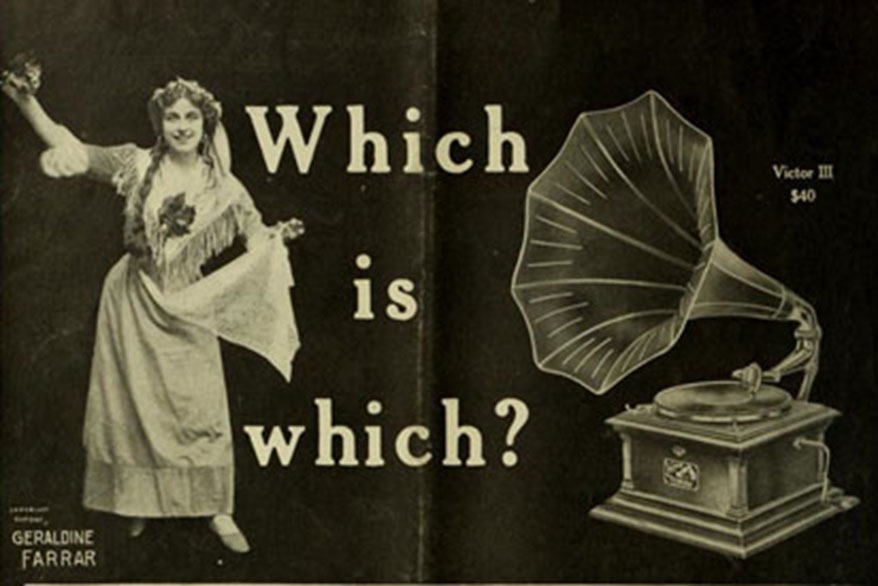
.
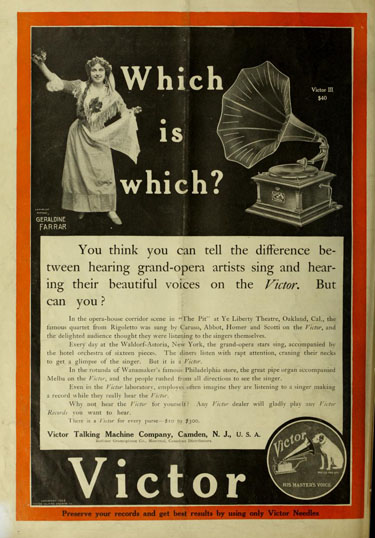
October 1908
See "Which
is which" for additional examples of this 1908 Victor advertising
campaign which focused on promoting the accuracy and realism of the
talking machine by asking the question: Can you really tell the difference
between the actual performer and the Victor record?
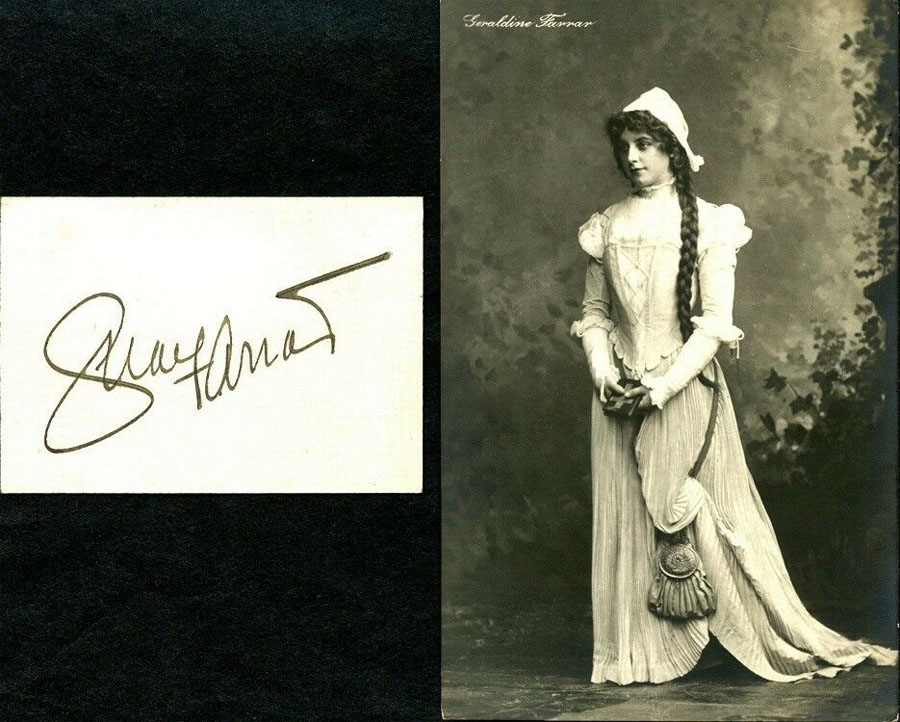
Geraldine Farrar, celebrity
postcard and autograph
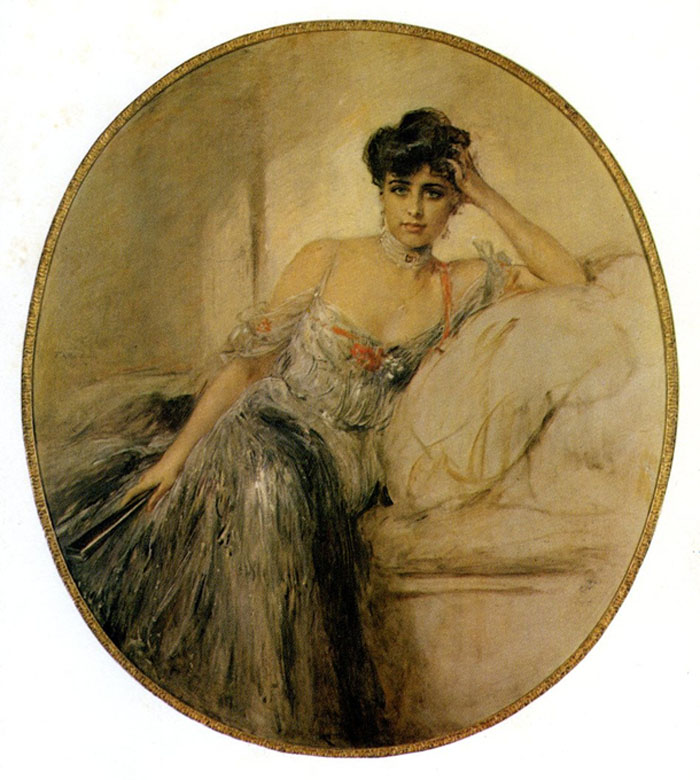
Geraldine Farrar, a portrait
in oils by F. A. Kaulbach, 1904, Courtesy Library of Congress
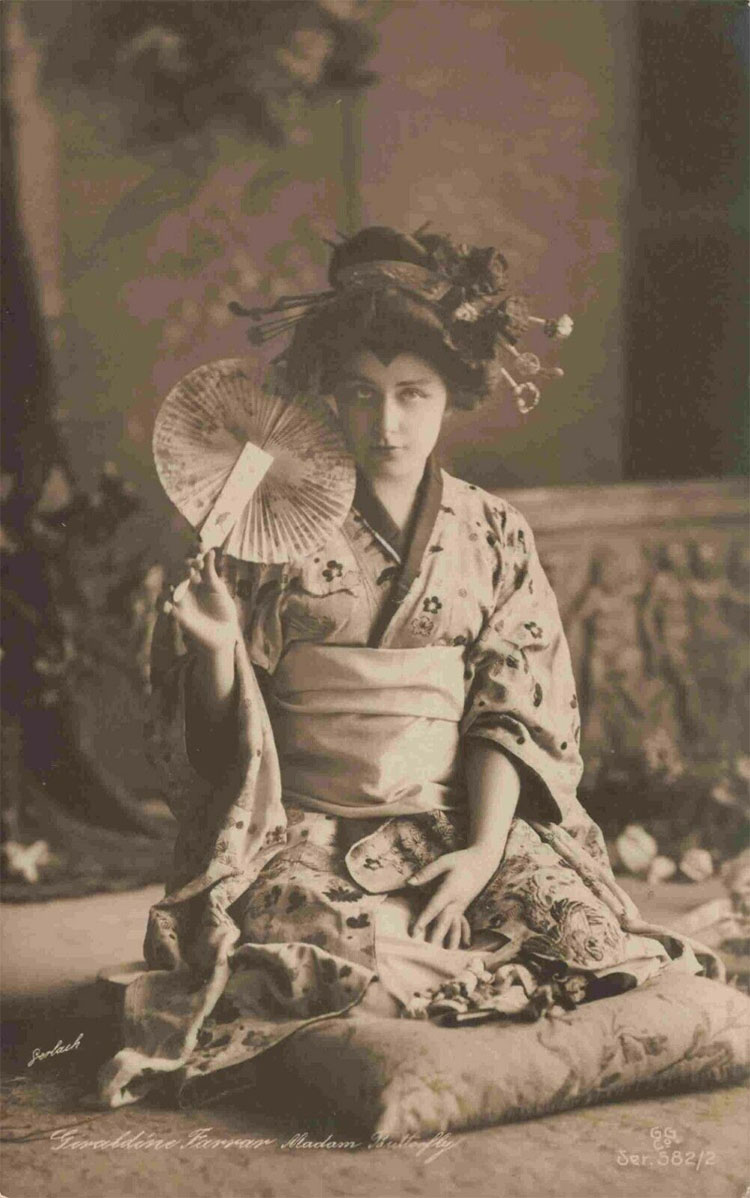
Geraldine Farrar in "Madam
Butterfly," postcard circa 1907
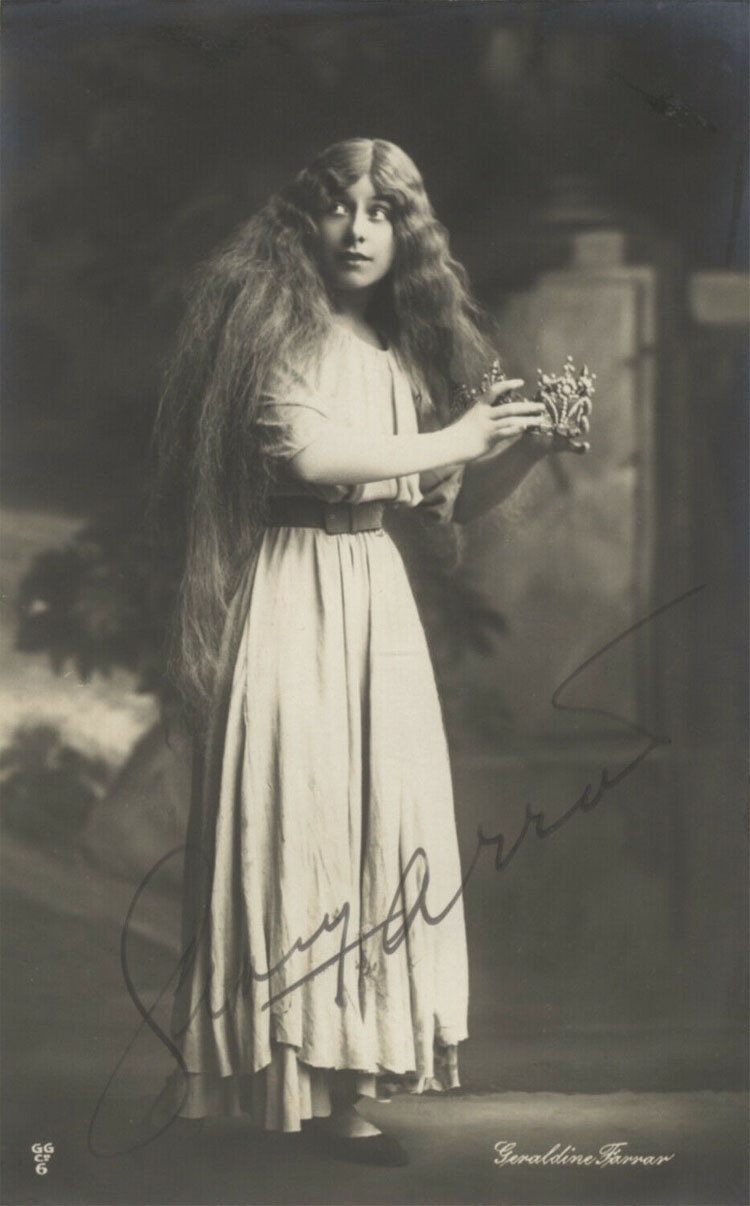
Geraldine Farrar, celebrity
postcard and autograph circa 1910
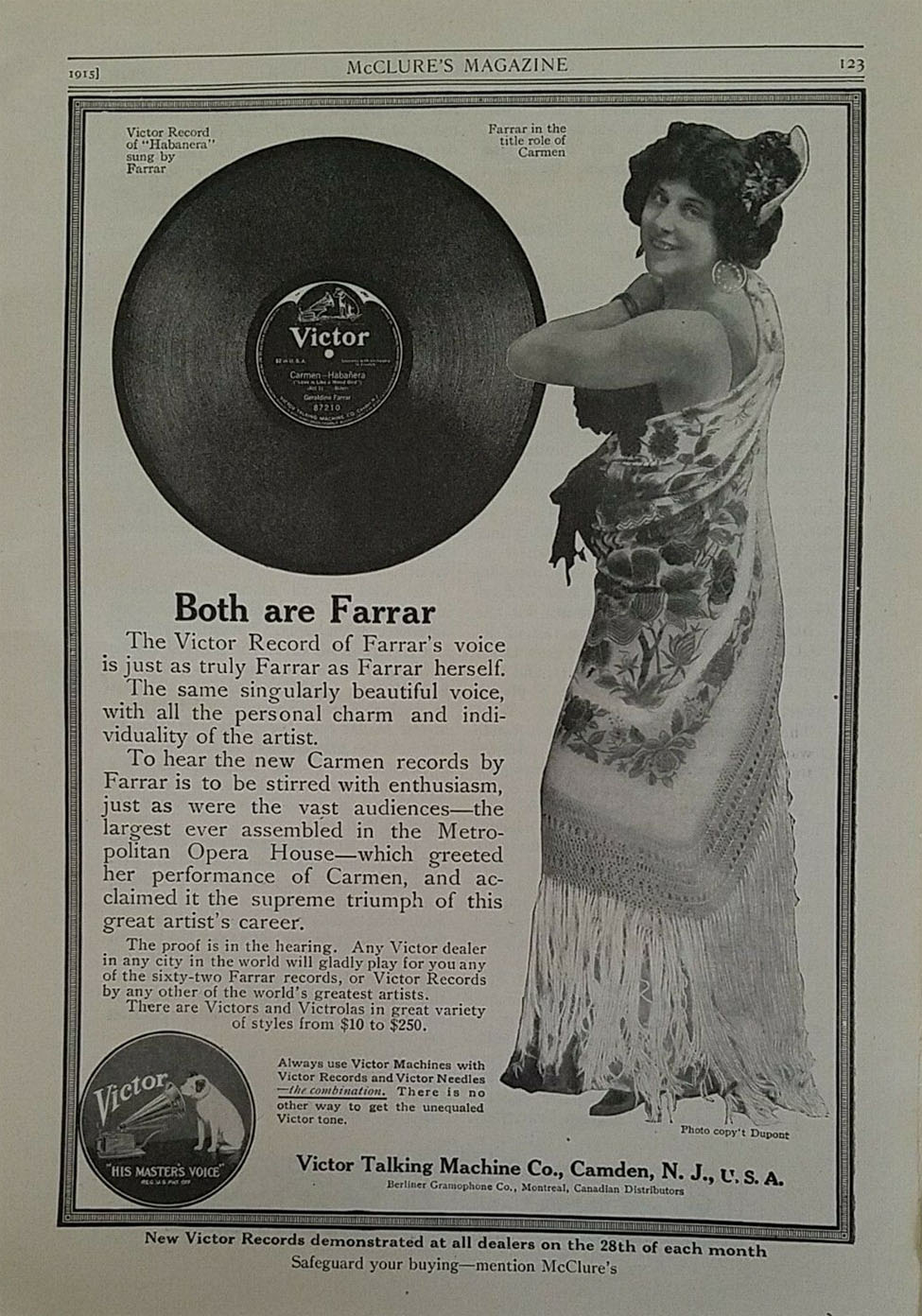
Both are Farrar, McClure's
Magazine, 1915
See "Both
are" for additional examples of the 1914 - 1916 advertising
campaign which wanted to assure consumers that what you were purchasing
was "just as truly" the artist as the artist him or herself.
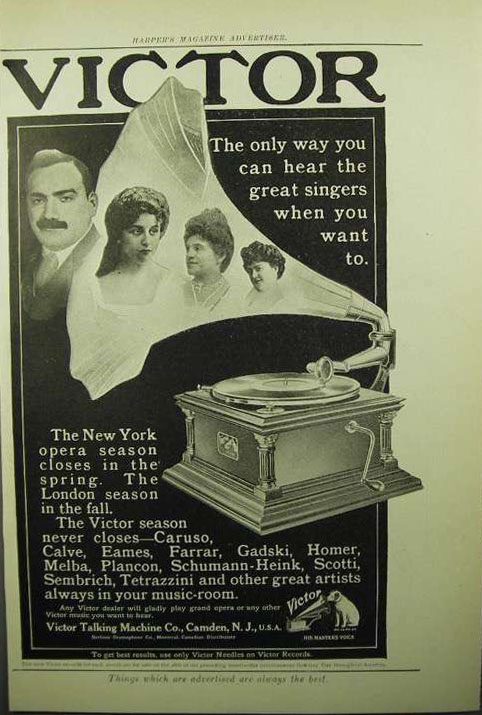
Caruso and Farrar, Harper's
Magazine, 1908
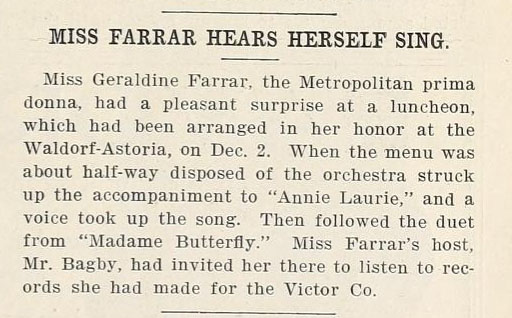
The Talking Machine
World, December 1908.
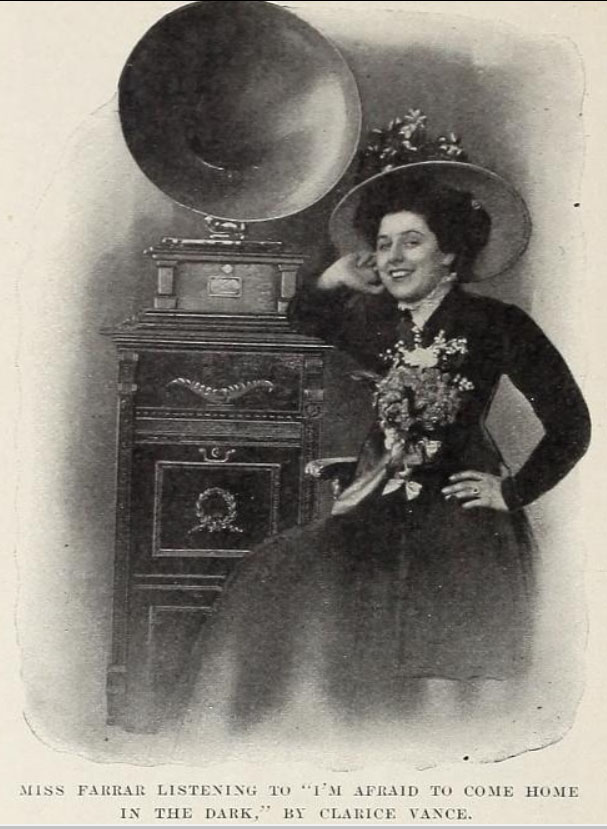
Farrar taking a tour of the Victor factory
in Camden, N.J., April 15, 1908 Talking Machine World and listening
to a Victor V Talking Machine.
It was noted in the article that "Miss
Farrar, who before signing an exclusive agreement with the Victor,
had previously made records in the laboratories of the principal European
companies, was greatly impressed at the magnificent equipment of the
Victor plant, and at the care and attention which marked every part
of the process of record taking."
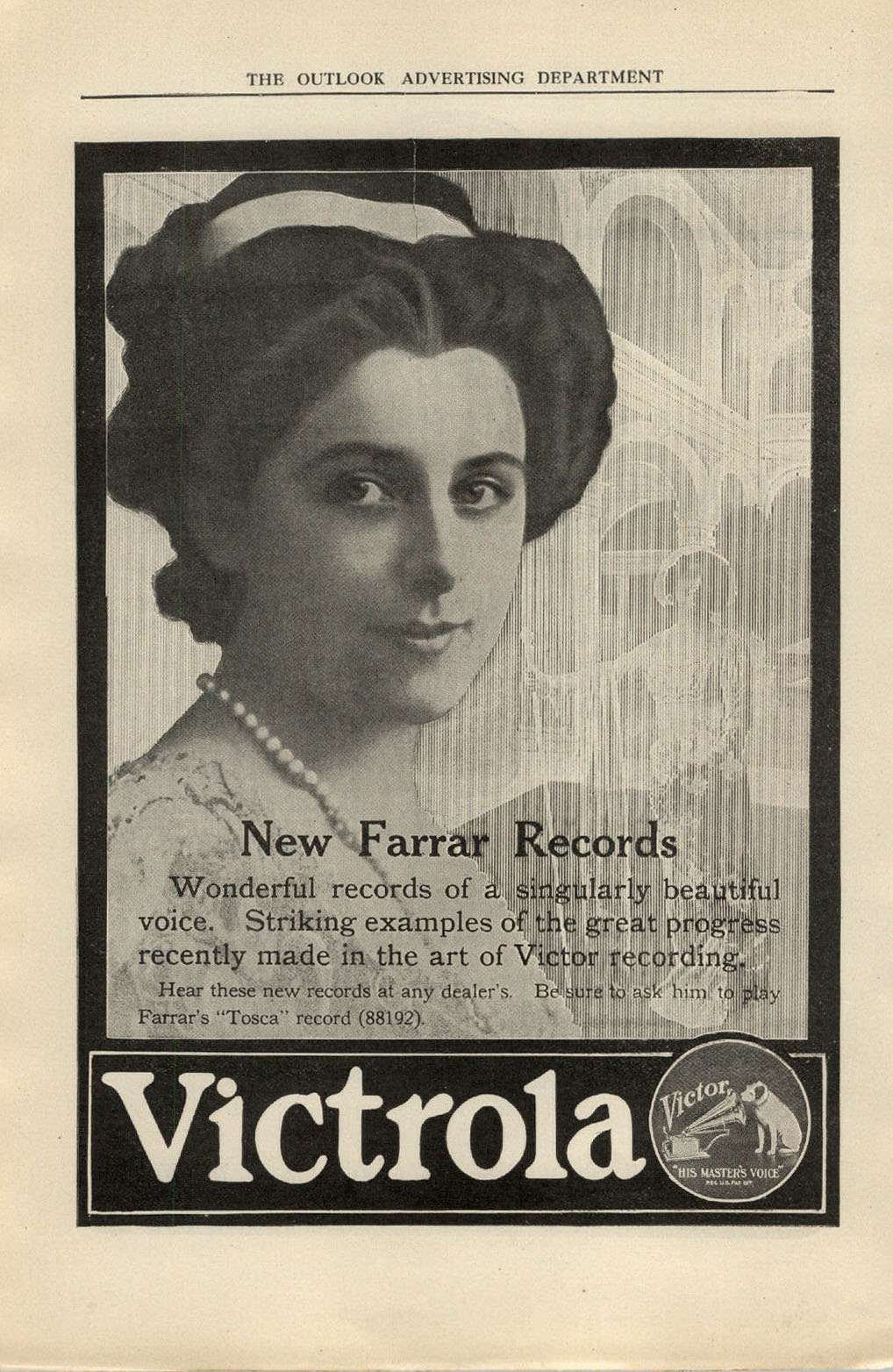
The Outlook Magazine,
1909
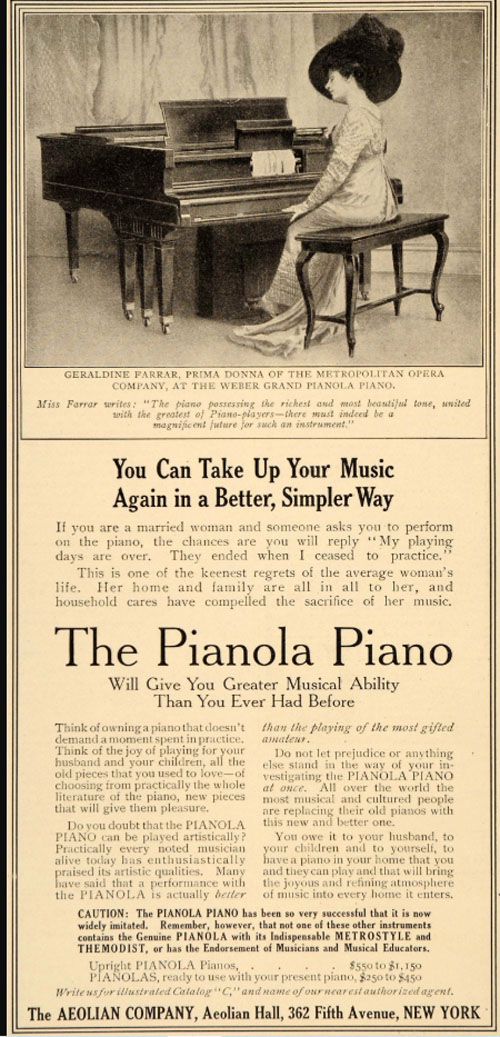
1909
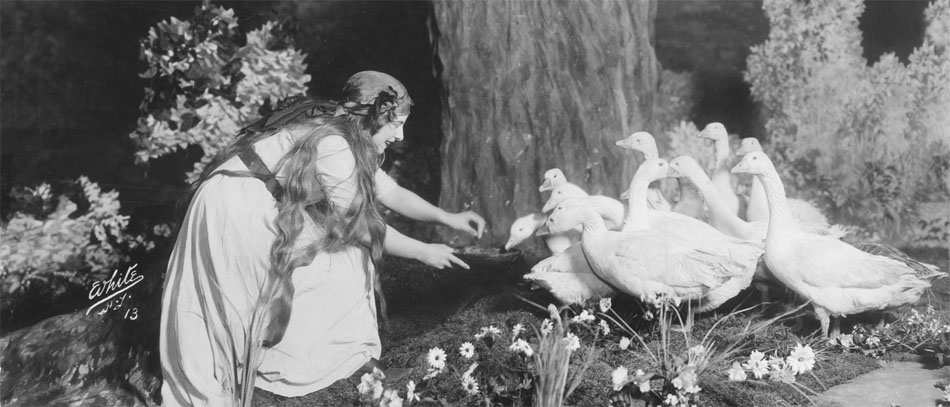
Geraldine Farrar as the
Goosegirl in Humperdinck's Königskinder, 1910. (Courtesy Metropolitan
Opera Archives)
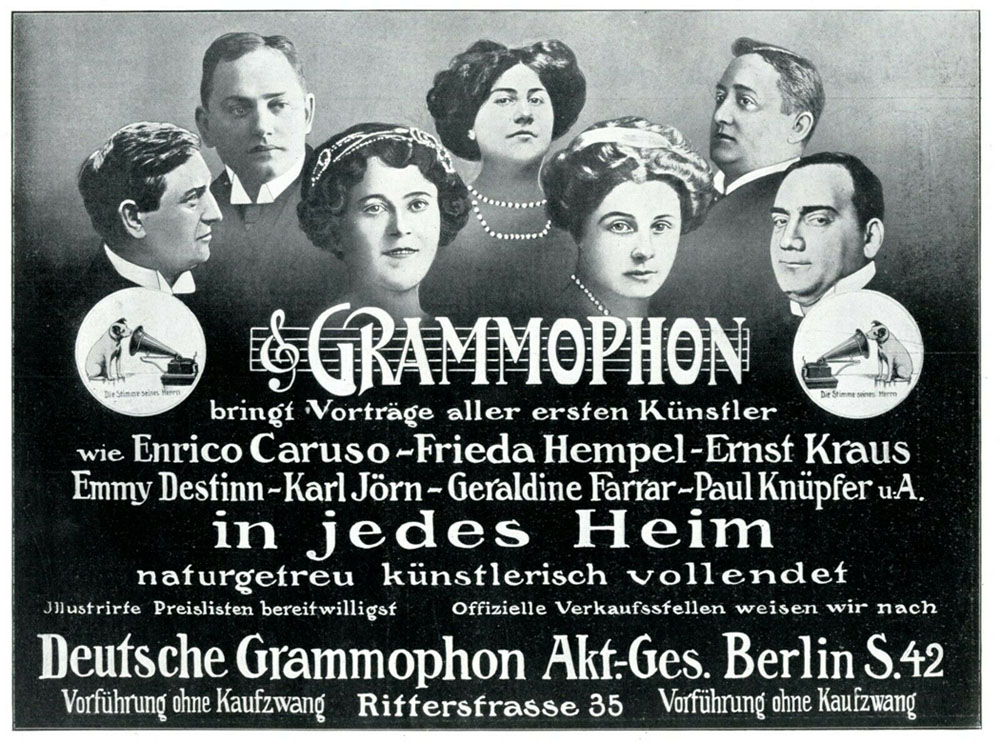
Deutsche Grammophon magazine
ad with Geraldine Farrar (7" x 9.75") 1911
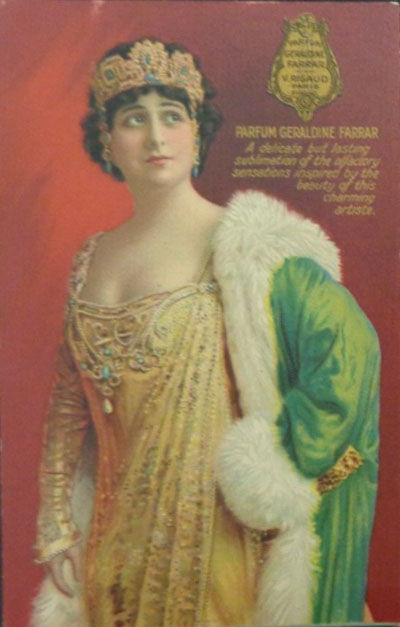
Parfum Geraldine Farrar
postcard advertisement
..
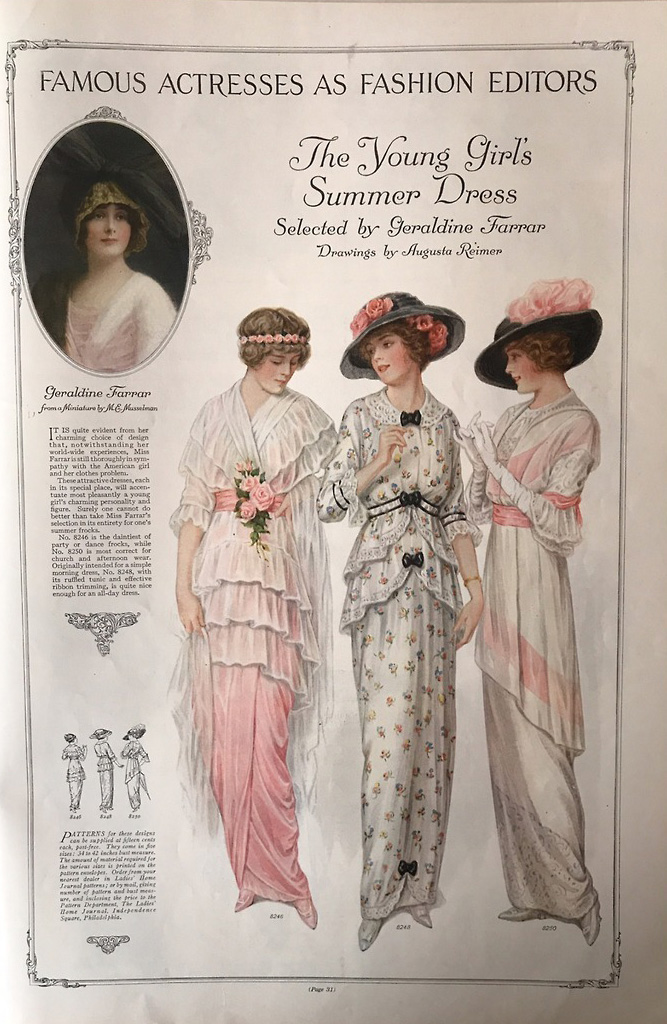
Geraldine Farrar as “fashion
editor” The Ladies’ Home Journal, 1914
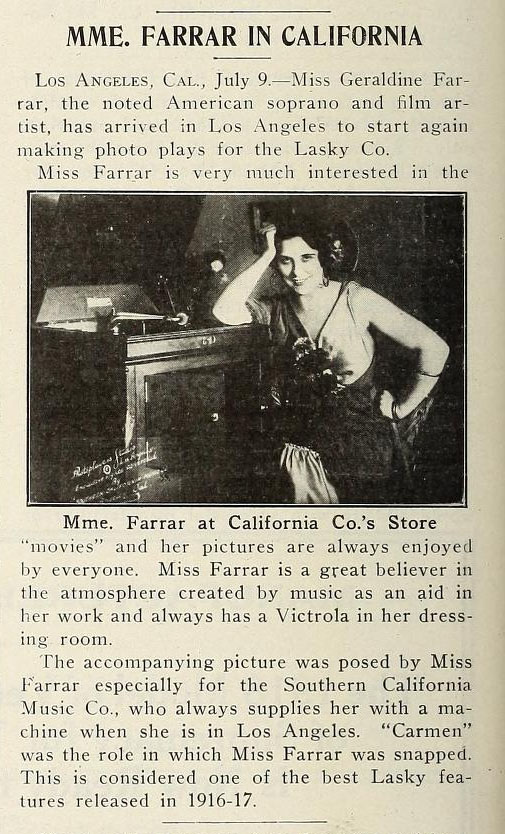
The Talking Machine
World, July 1917
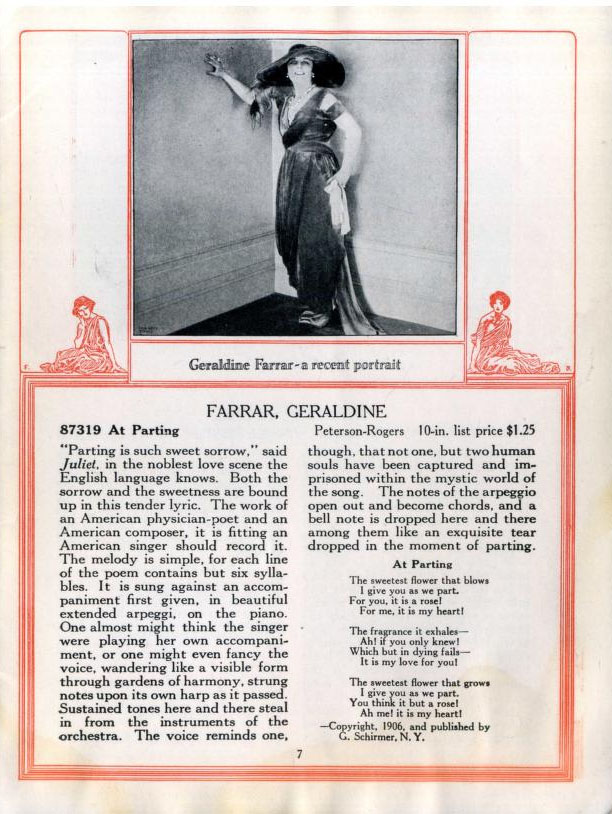
New Victor Records
December 1920
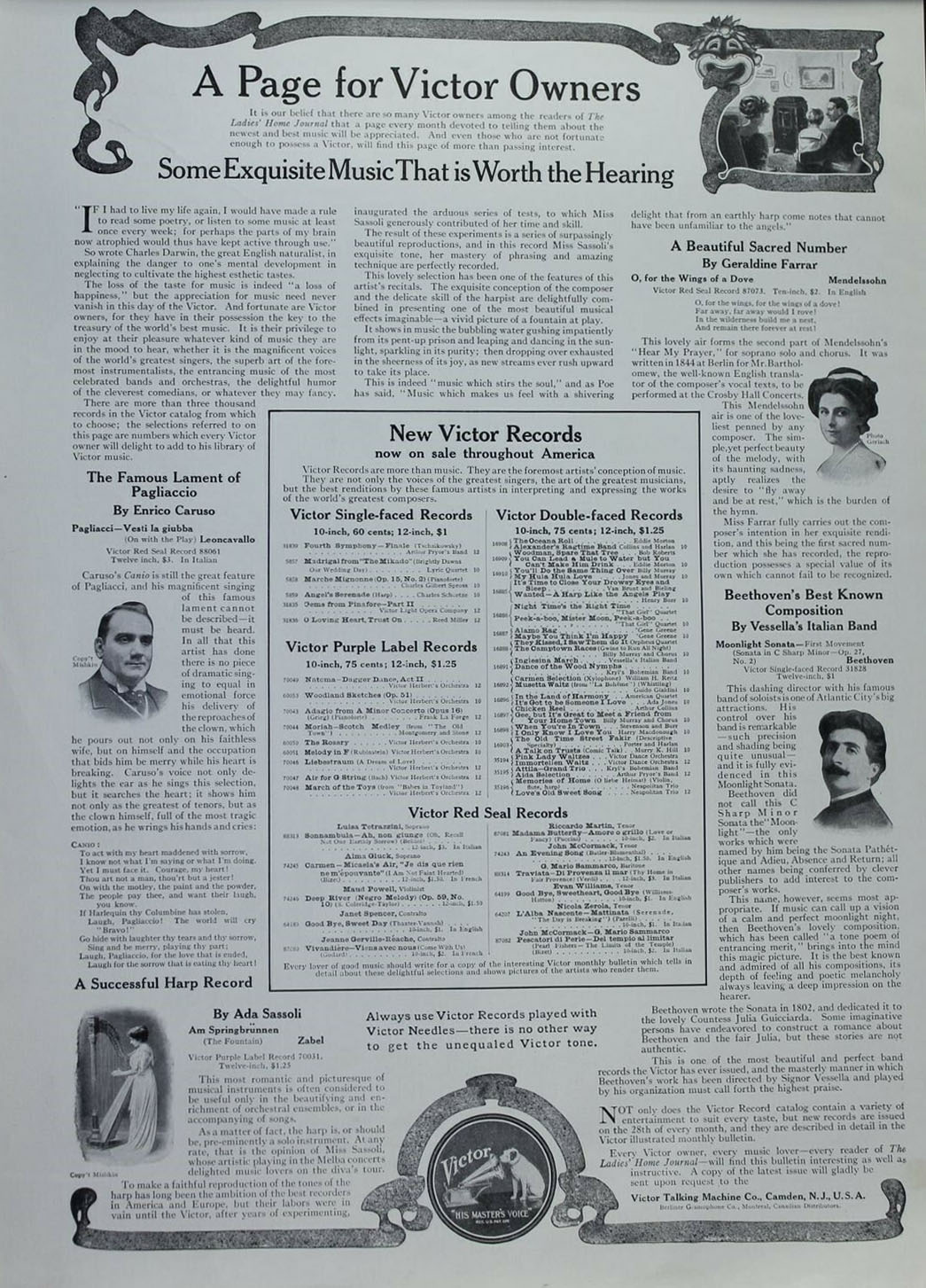
Farrar, "O, for the
Wings of a Dove," 1911
"Do not neglect to cultivate the
highest esthetic tastes." The loss of the taste for music
is indeed 'a loss of happiness...'
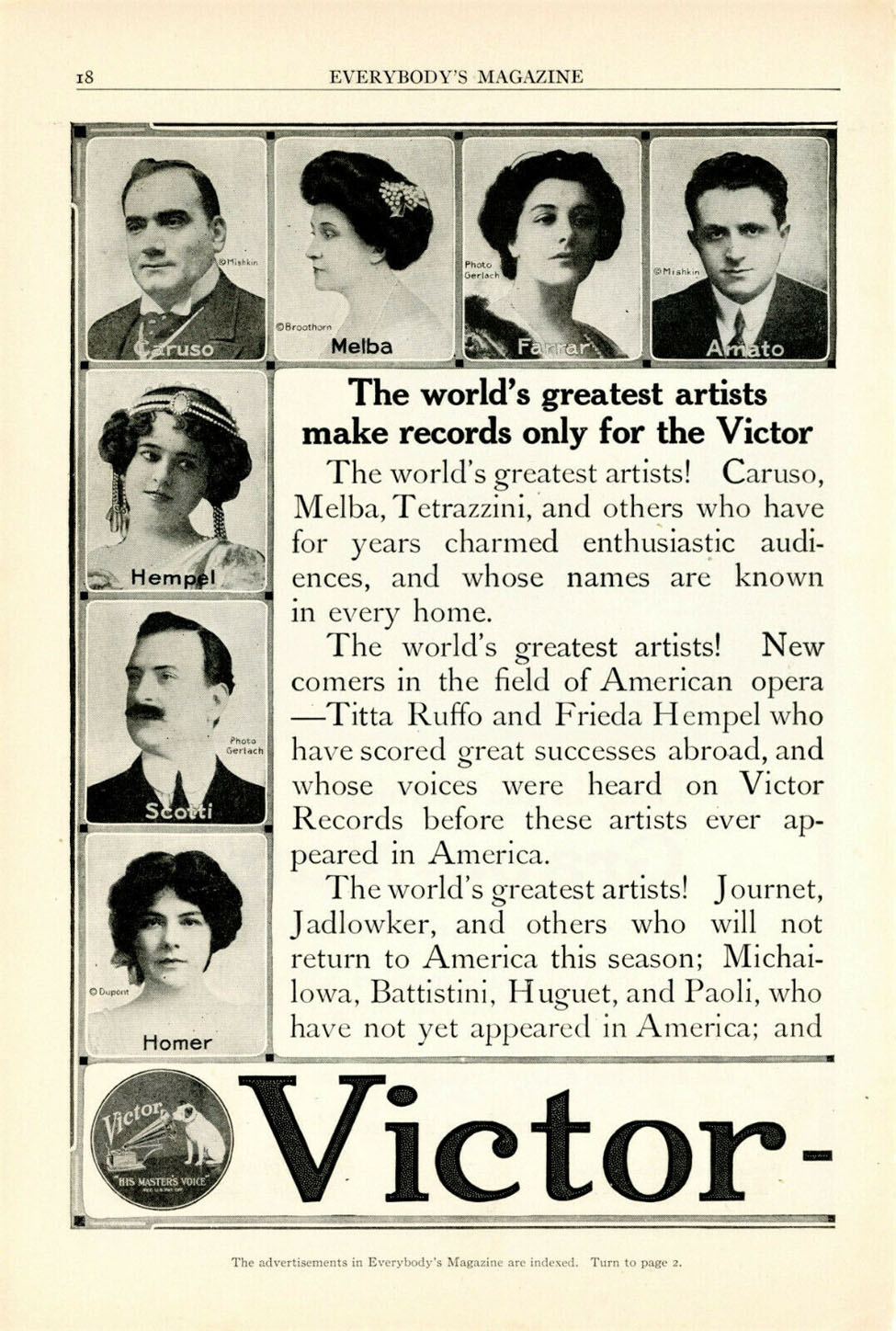
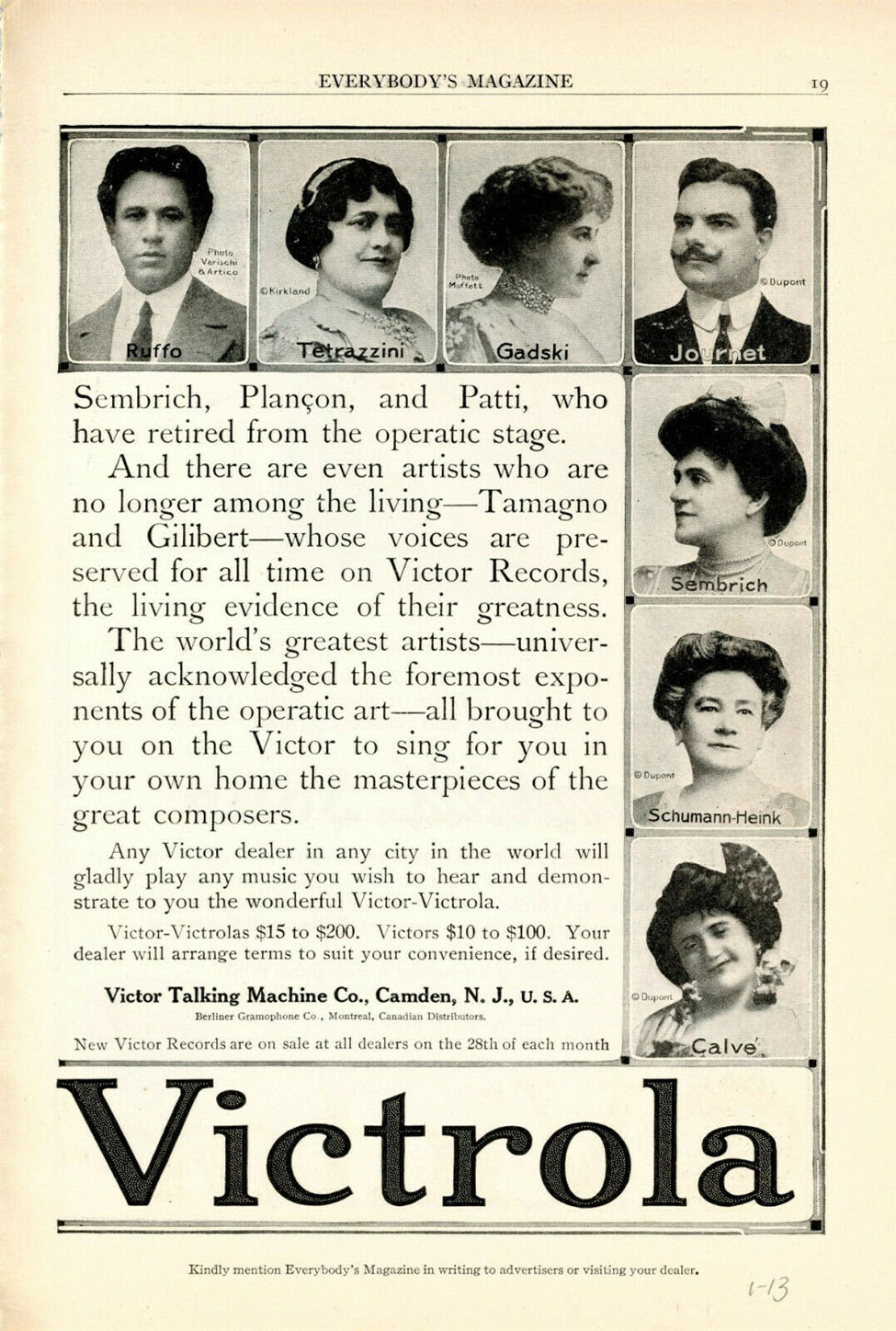
Farrar and Schumann-Heink,
Everybody's Magazine, January 1913 (Double page)
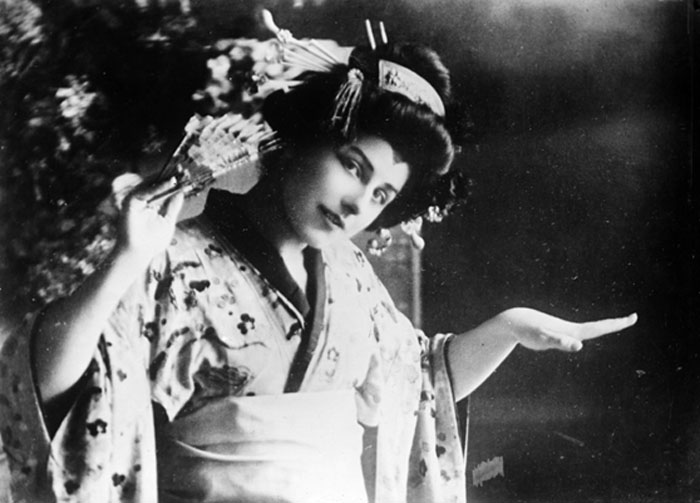
“You too can hear Miss Farrar just as
she hears herself and to hear her on the Victrola is just the same
as hearing her on the operatic or concert stage.” 1914
.
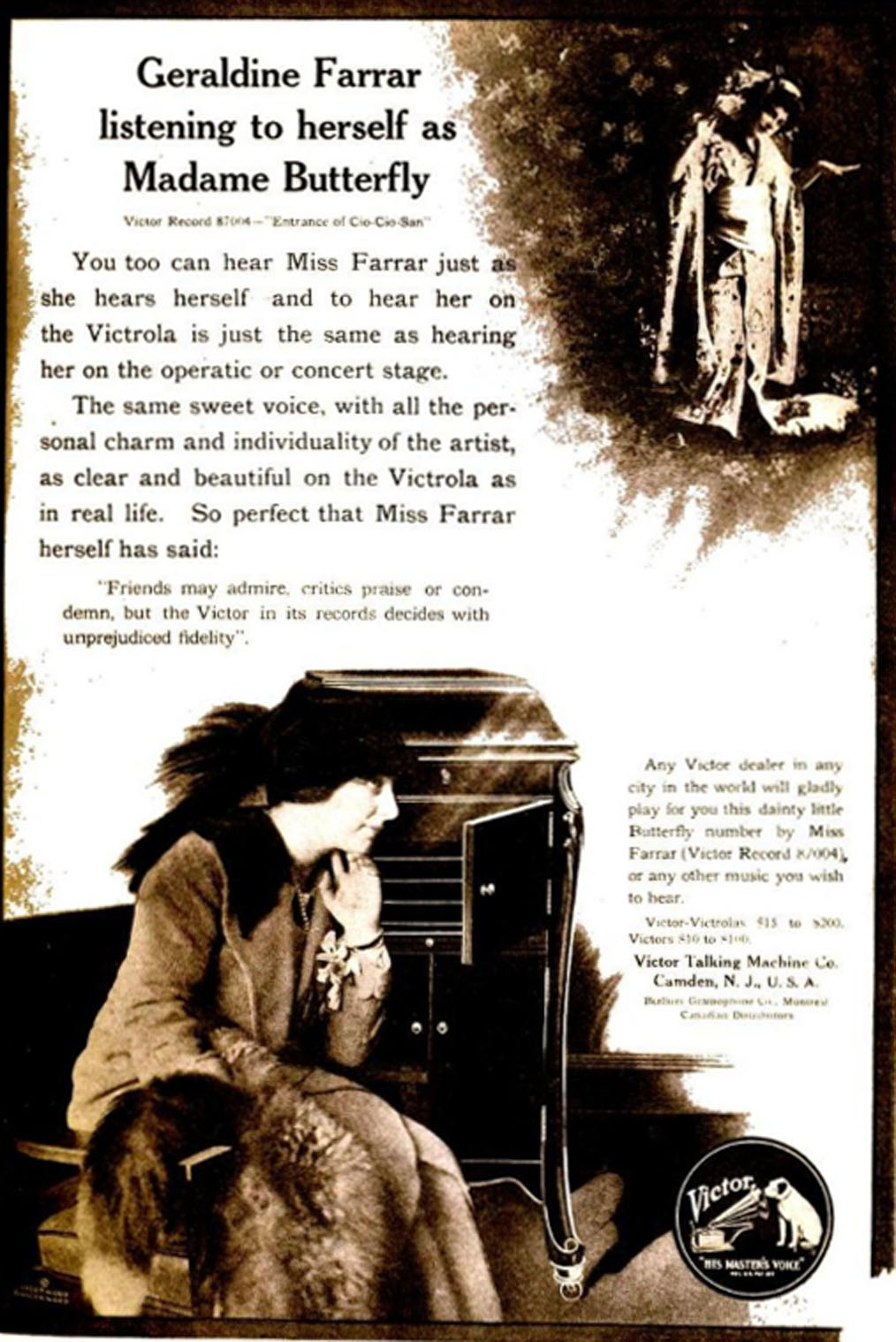
American Magazine,
1914
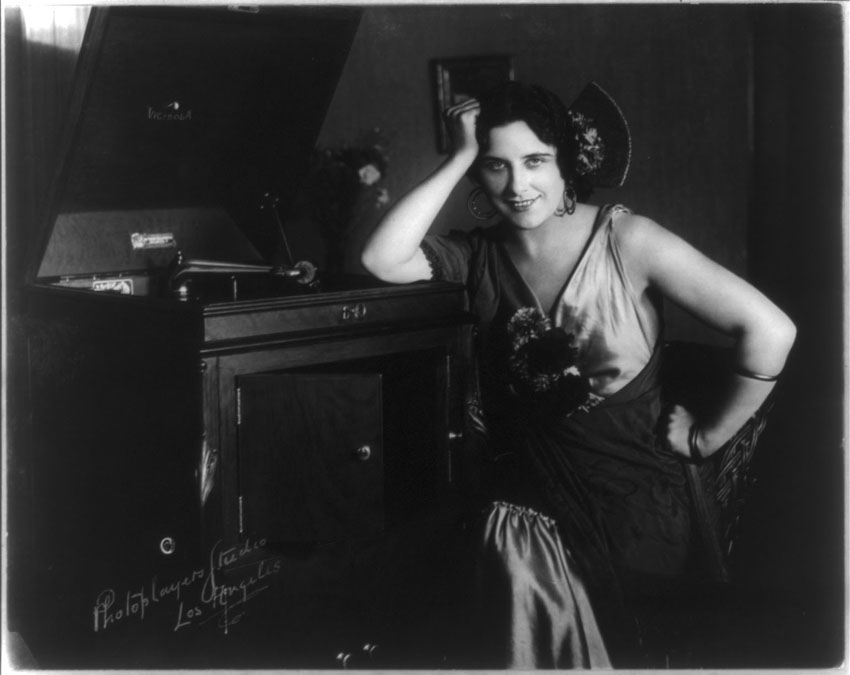
Farrar next to Victrola,
ca. 1915 (Courtesy Library of Congress)
Geraldine Farrar was a prolific recording
artist for Victor with 179 records listed in the "Discography
of American Historical Records" for Farrar between 1907 and
1927. Cather wrote in Three American
Singers that Farrar has a “hold on the baseball type of American”
and doubted that Farrar would be flattered by her popularity with
those who are “proverbially bored by the art in which she excels.”
“But she must at least be pleased that the phonograph companies find
it necessary to issue a new Farrar record every month…”
Miss Farrar's story is one that the
ranchman or the miner can understand; it gratifies his national pride,
meets his sense of the picturesque. When he puts a "Farrar record"
into his phonograph, he has something of the feeling of part-ownership
that our fathers had when they spoke of Mary Anderson as "our Mary."
Three
American Singers by Willa Sibert Cather, McClure's Magazine,
December 1913.
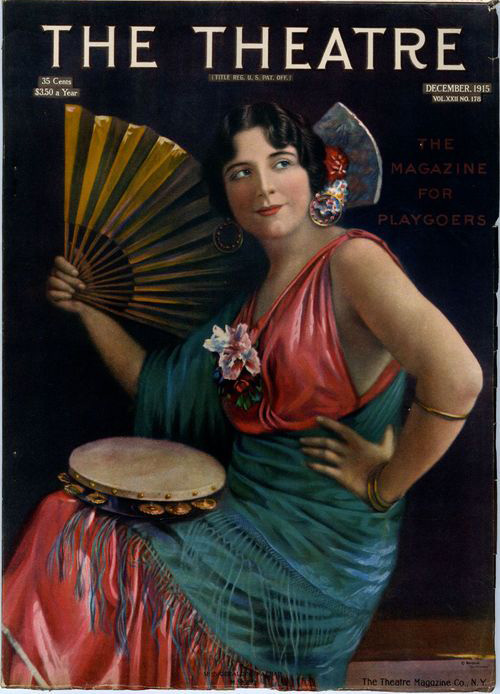
Farrar on cover of The
Theatre, December 1915

Miss Geraldine Farrar in "smart
French Felt" hat, newspaper clipping 1915, Courtesy New York
Public Library Picture Collection
Farrar was an exclusive recording artist
for Victor but she also had a perfume named after her, advertised
for the Weber Pianola, a player piano, Steinway pianos, and Cutex
polishes. Besides her operatic career and her recording career with
its numerous full page phonograph ads she also became a film star
making 14 silent movies from 1915 to 1920. Farrar was a true celebrity
with her own following of young women known as “Gerry-flappers.“
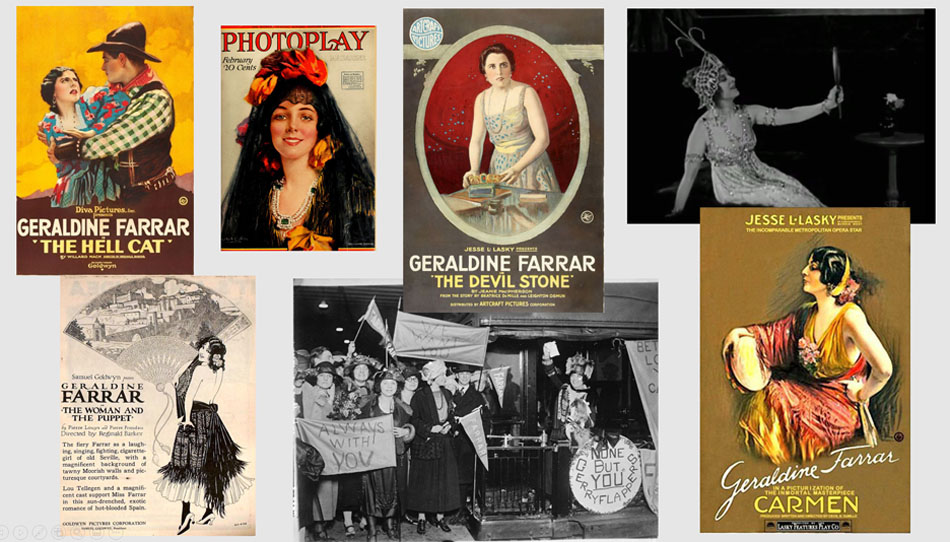
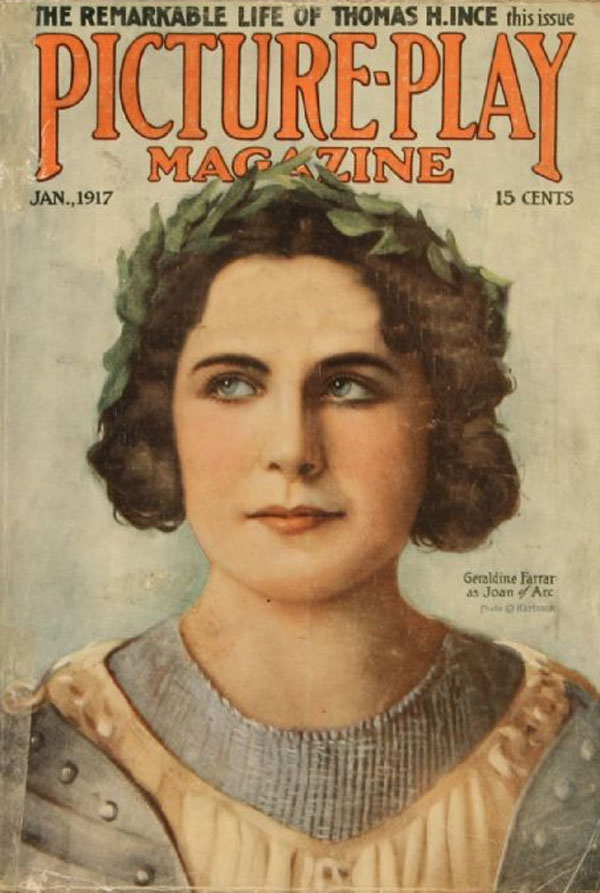
Geraldine Farrar as Joan
of Arc, Picture-Play Magazine
, January 1917
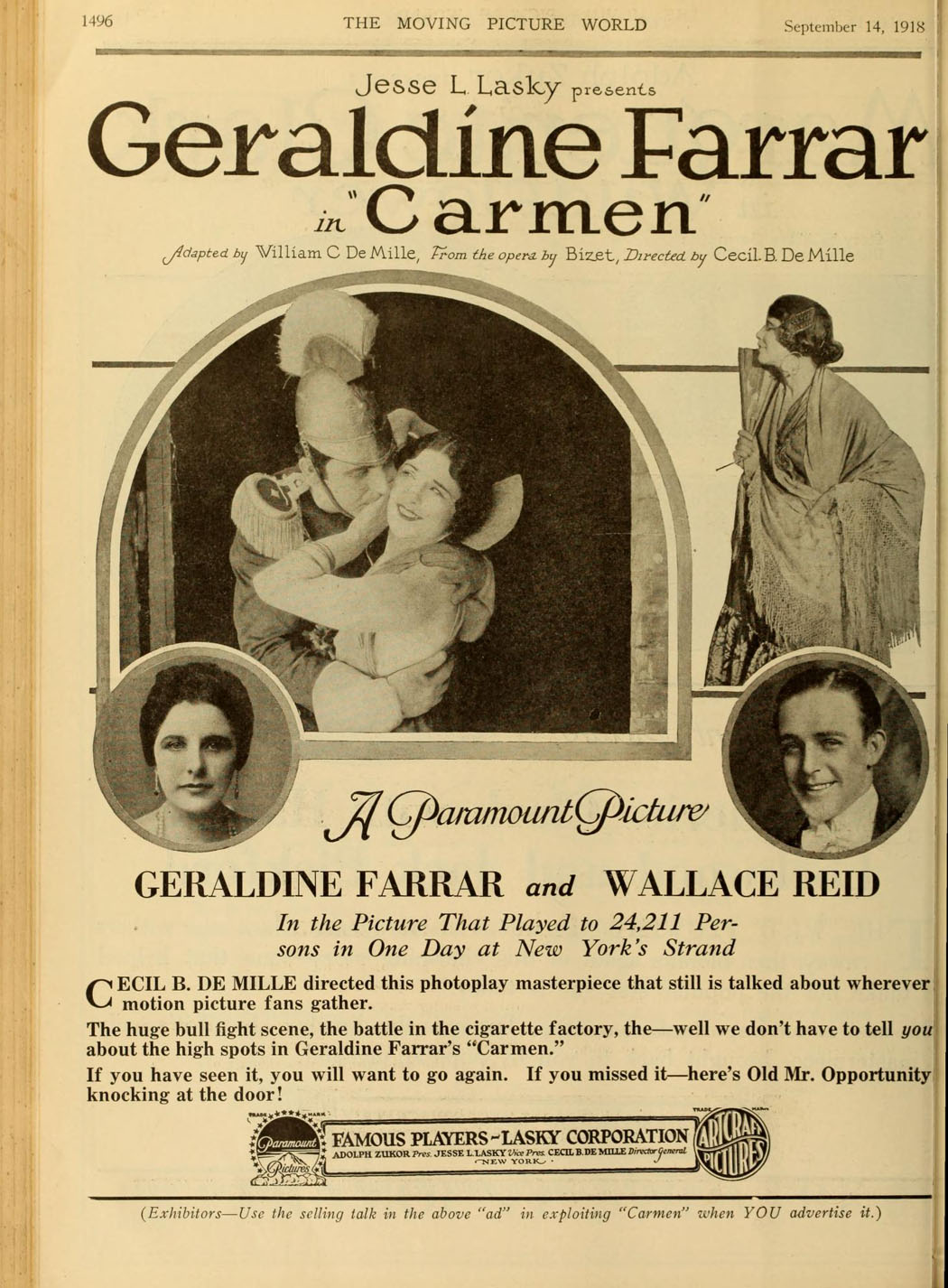
Farrar in "Carmen"
The Moving Picture World, September 1918
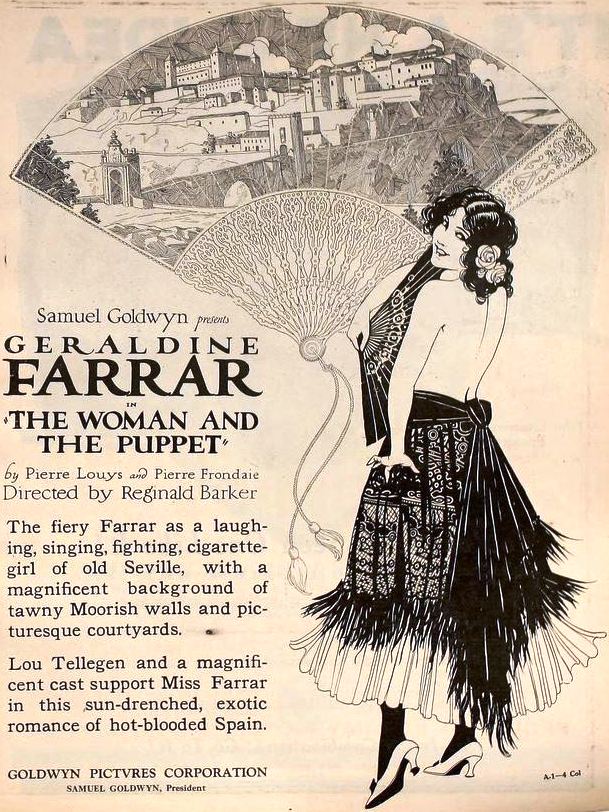
Motion Picture
News, April 17, 1920

Geraldine Farrar on Cover of PhotoPlay Magazine, February 1919

1918 Farrar approved, May
1918
Geraldine Farrar
and Mme. Schumann-Heink
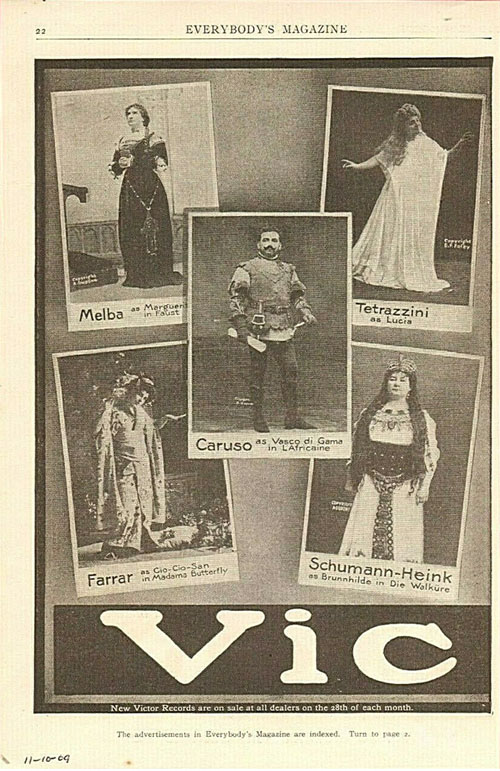 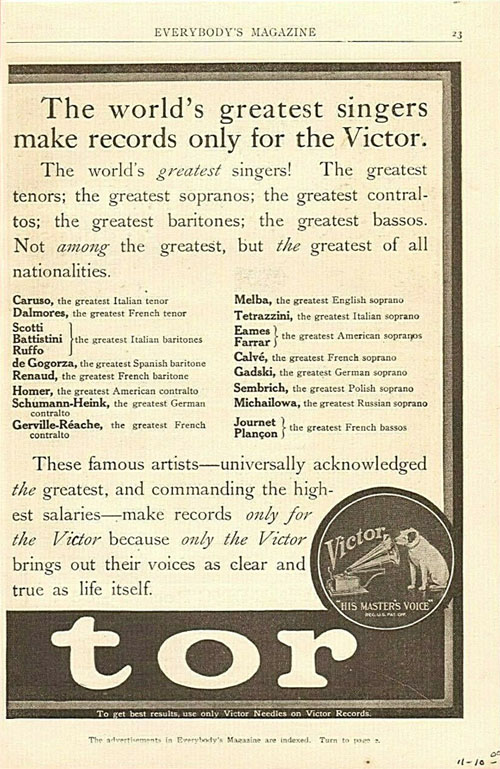
Farrar and Schumann-Heink,
November 10, 1909

Farrar and Eames, the greatest
American sopranos, 1911.
.
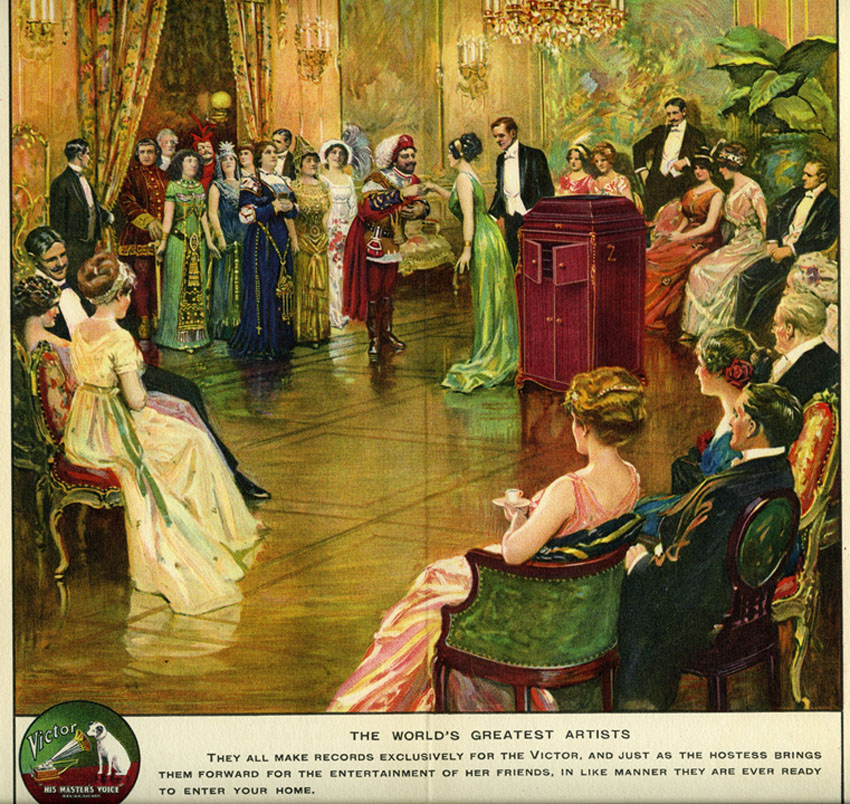
Exclusivity and hosting the world’s
greatest artists like Farrar and Schumann-Heink (with Caruso of course
here leading the procession) were privileges that came with owning
a Victor. Wealth and high social status were obvious and intended
parts of these ads. Victrola Christmas Brochure, 1914

Farrar and Schumann-Heink,
The Literary Digest, February 26, 1916
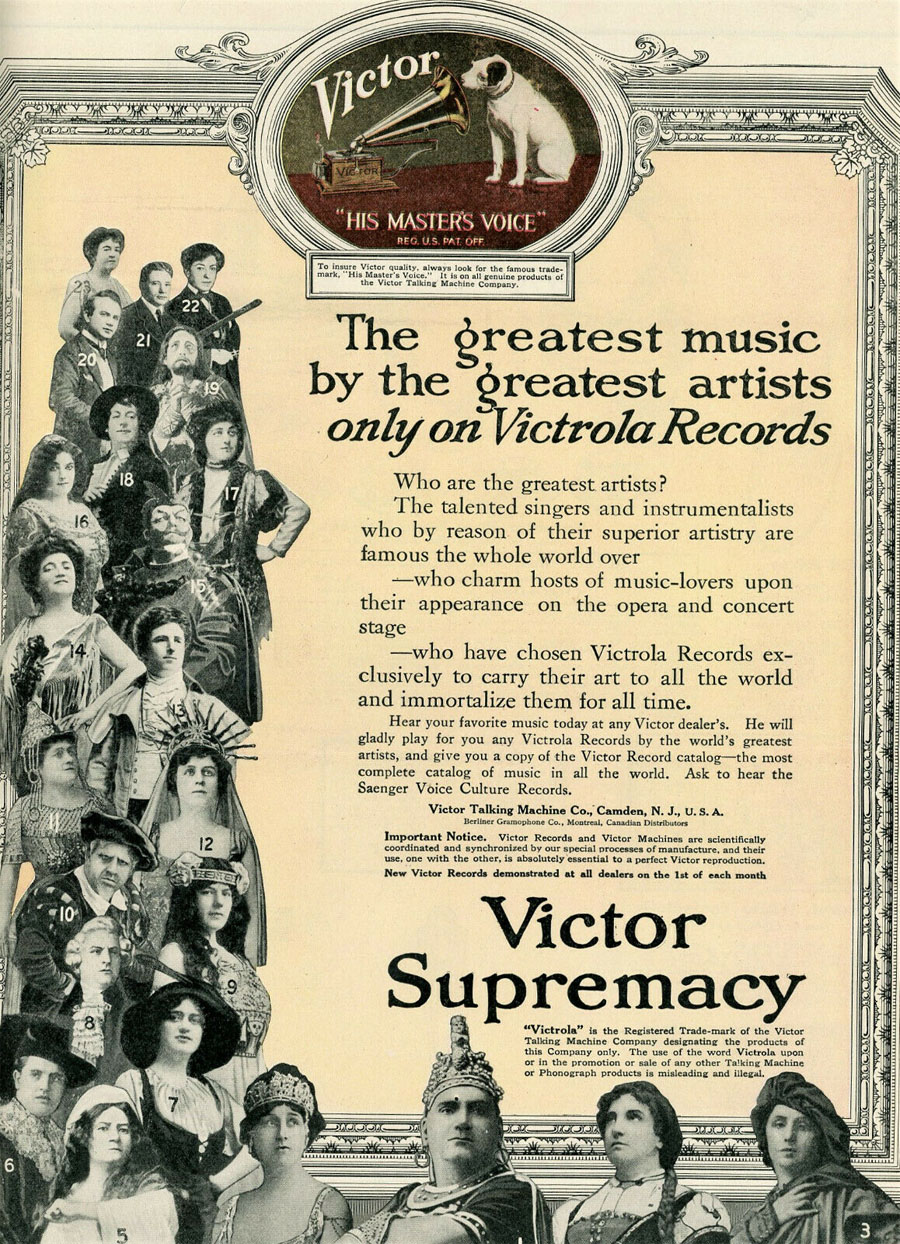
Farrar to left of Caruso,
"Victor Supremacy" c.1917
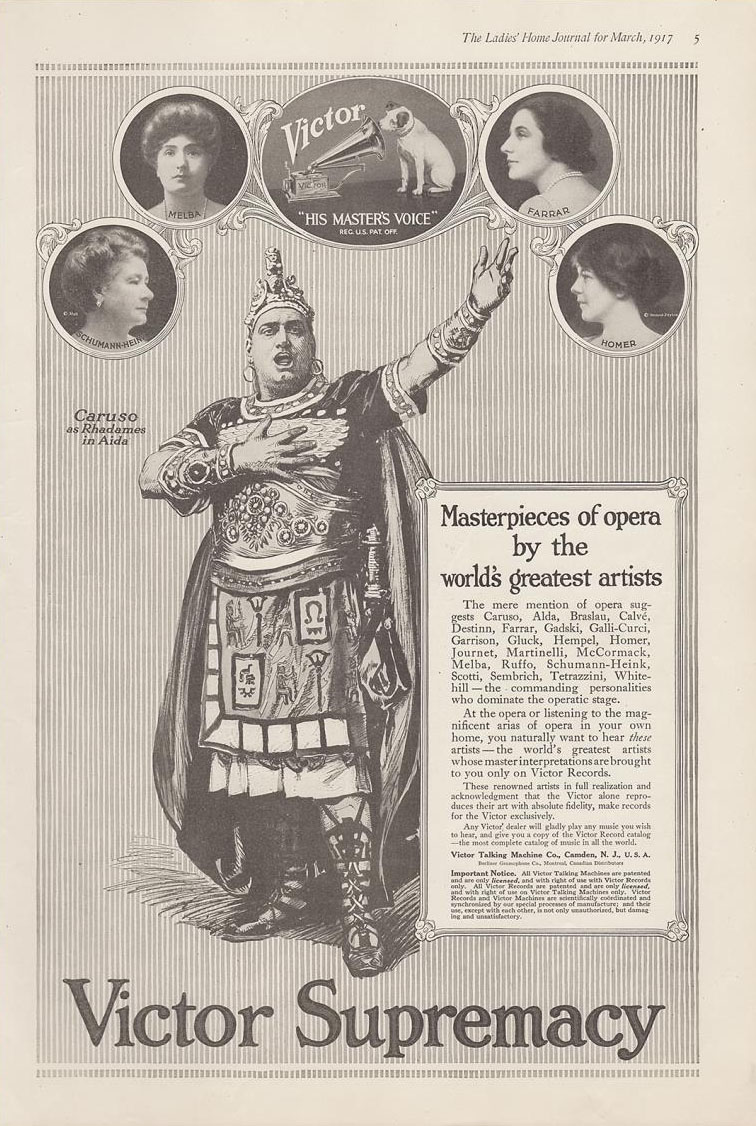
Farrar and Schumann-Heink
-- Masterpieces of opera by the world's greatest artists, "Victor
Supremacy" March 1917.
See Phonographia's Victor
Supremacy for more examples of this advertising theme.
.
Geraldine
Farrar, Mme. Schumann-Heink and Lucrezia Bori
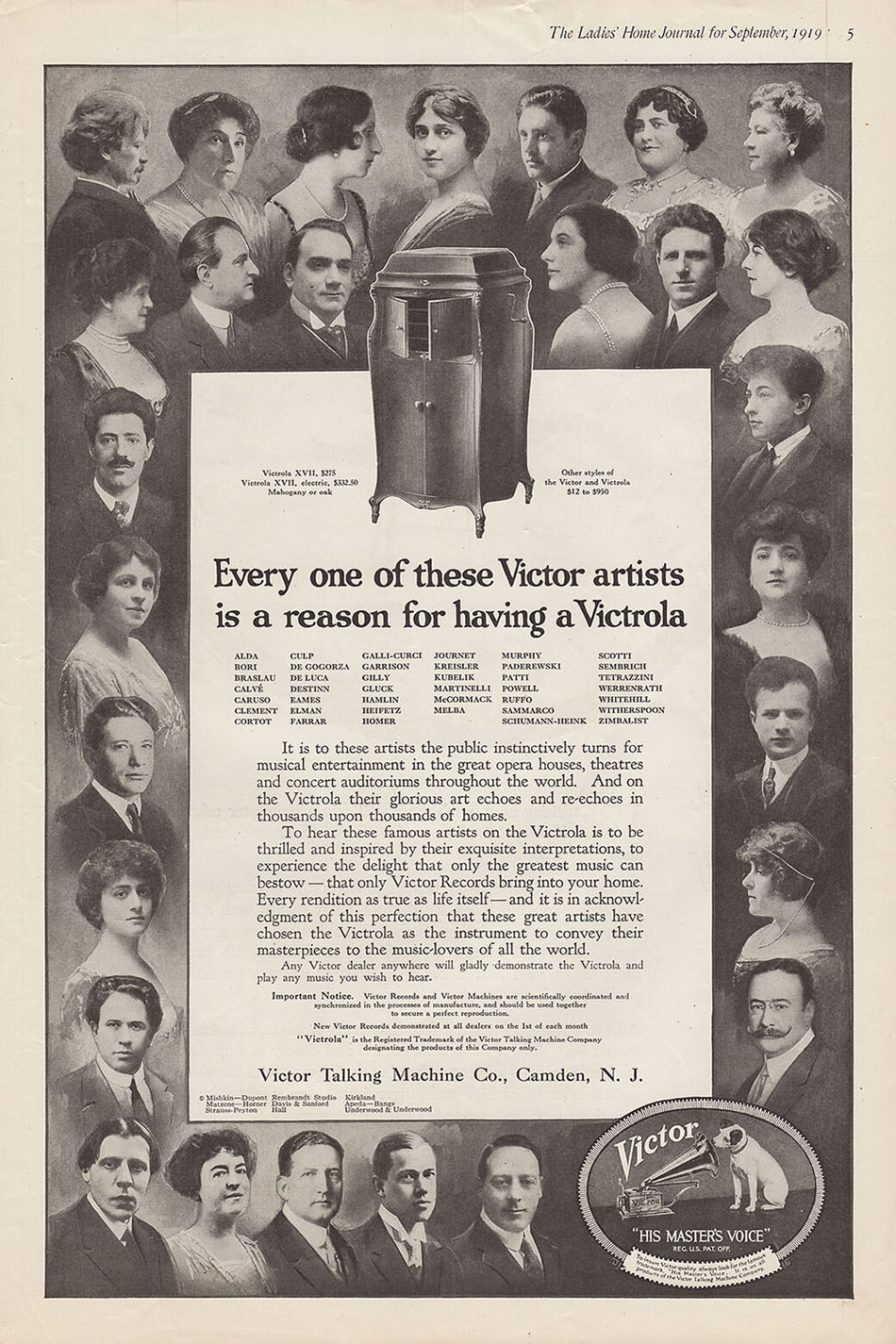
Farrar, Schumann-Heink
and Bori, The Ladies' Home Journal, September 1919
Geraldine
Farrar and Mme. Schumann-Heink
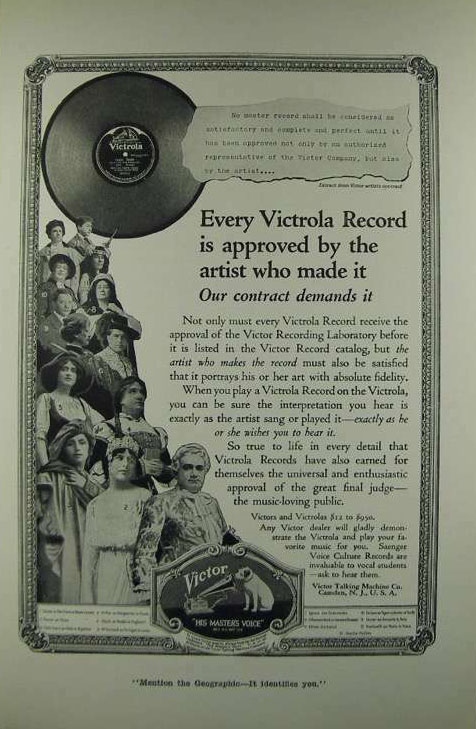
Farrar and Schumann-Heink,
the National Geographic 1919
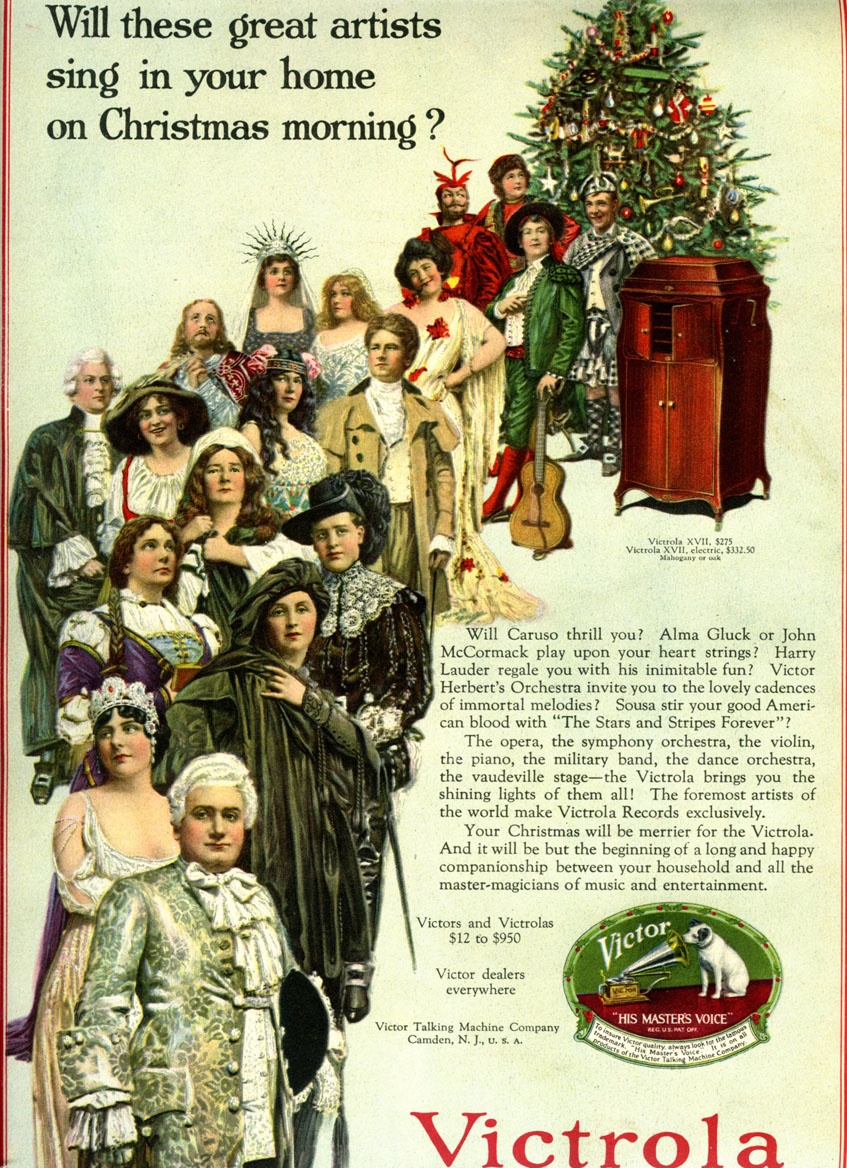
Farrar (behind Caruso in
front) and Schumann-Heink (behind Farrar), The Theatre Magazine
December, 1918
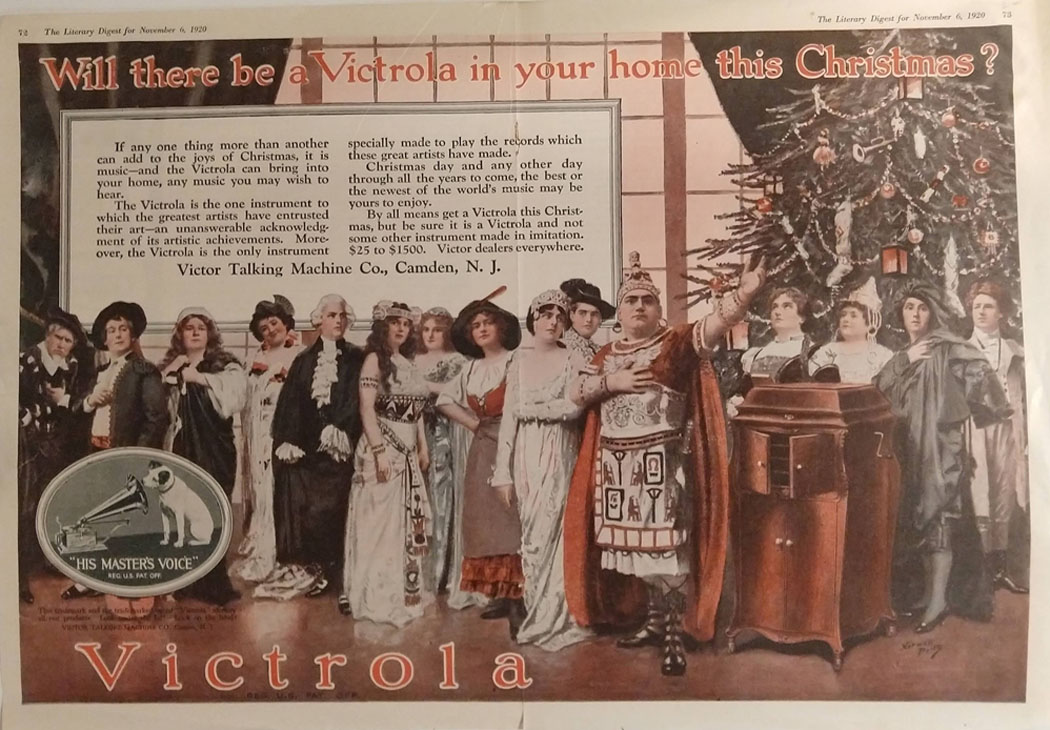
Farrar and Schumann-Heink,
The Literary Digest for November 6, 1920
Geraldine
Farrar, Mme. Schumann-Heink and Lucrezia Bori
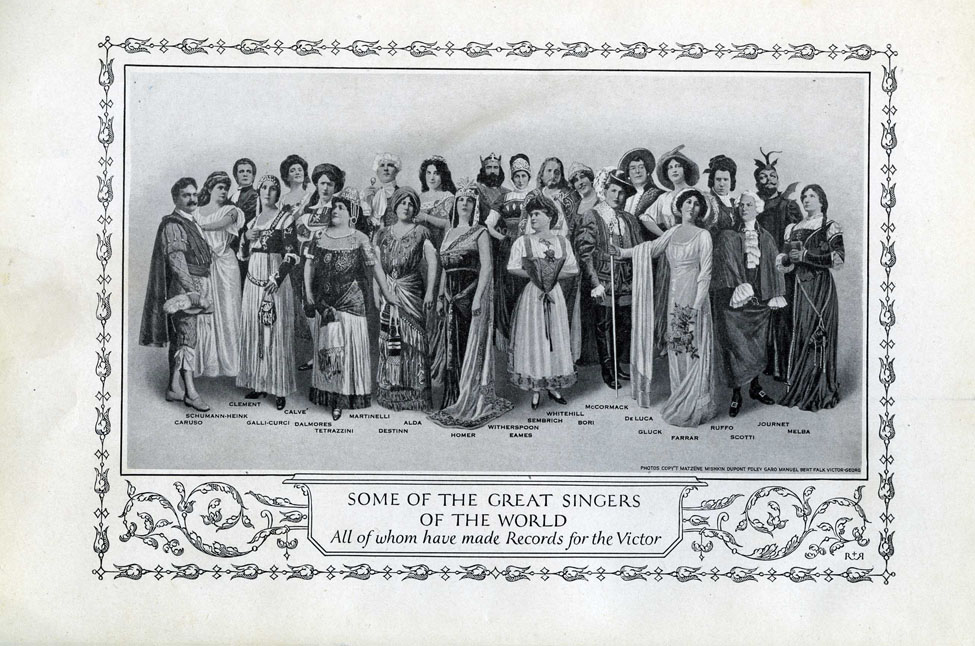
Farrar, Schumann-Heink
and Bori, Victrola Book of the Opera, Sixth Edition, 1921
From 1912 - 1976 the Victor Talking
Machine Company published their Victor Book of the Opera with
stories, illustrations and record lists of Grand Operas. The
many illustrations and records related to Geraldine Farrar can be
seen by visiting Phonographia's The
Victrola Book of the Opera 1921.
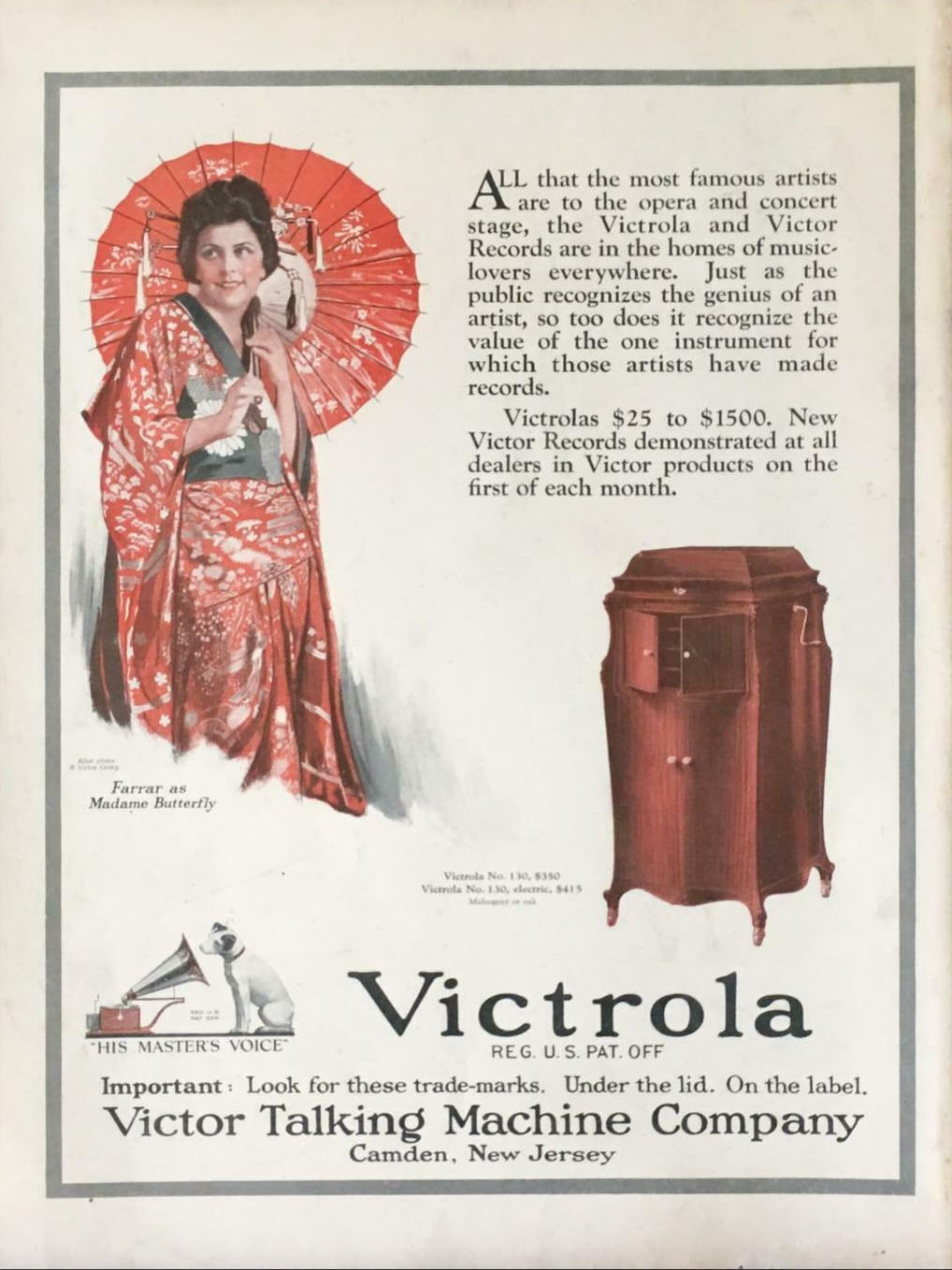
Farrar as Madame Butterfly,
1921
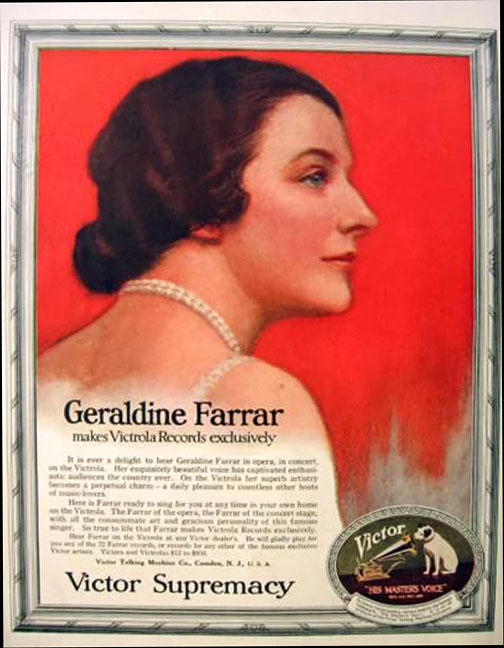
Geraldine Farrar makes
Victrola Records exclusively, 1919

"It is quite fitting
that so good an American as Miss Farrar" sing her rendition which
"is quite an inspiring one." Victor Records Catalog
August 1916
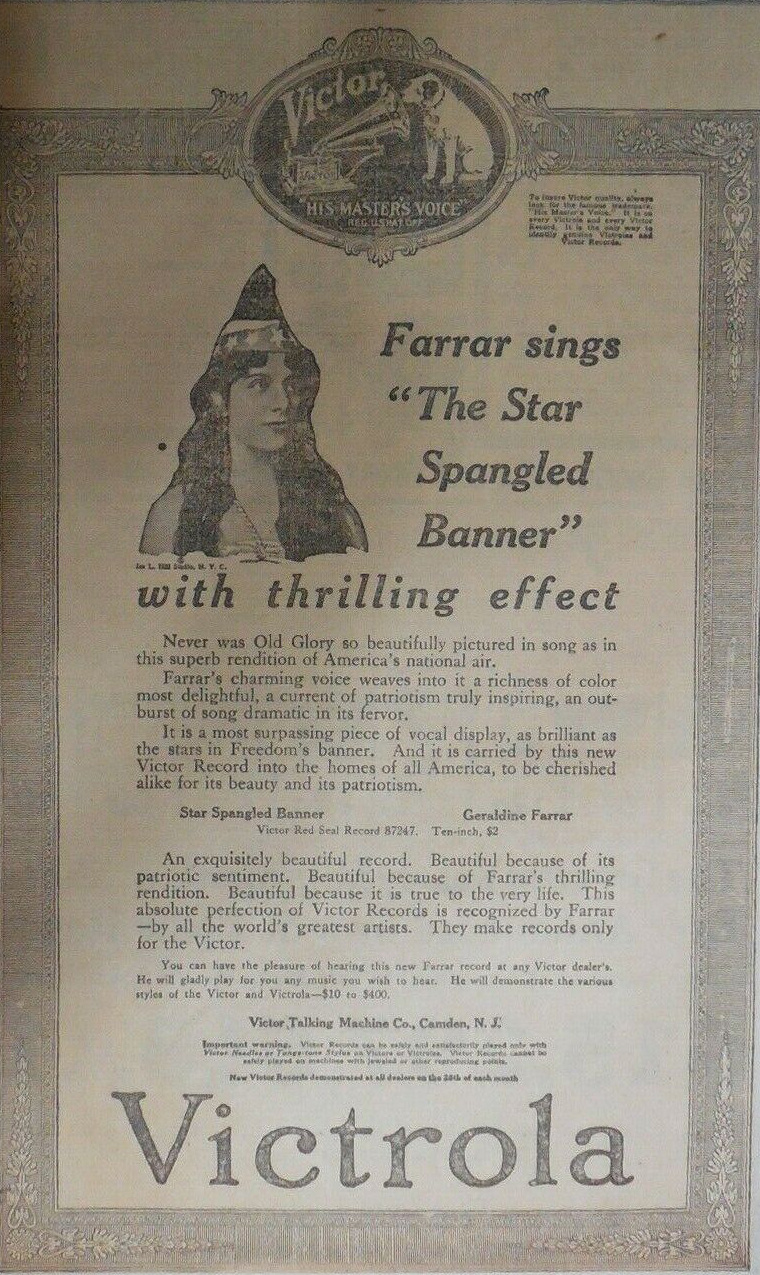
Farrar sings "Star
Spangled Banner" Newspaper ad 1919
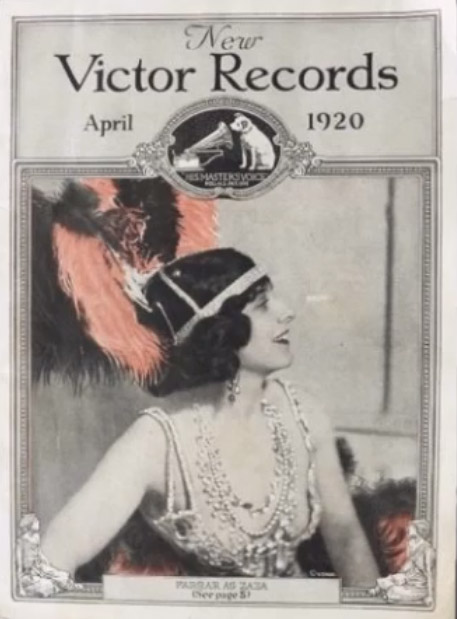
Farrar as Zaza, Victor
Records Catalog for April 1920
.

Headline from New York
Times article on April 23, 1922 about Farrar's farewell performance
at the Met.
For timeline of Farrar's career using
newspaper accounts see The
Parterre Archives by LA
CIECA on August 07, 2015
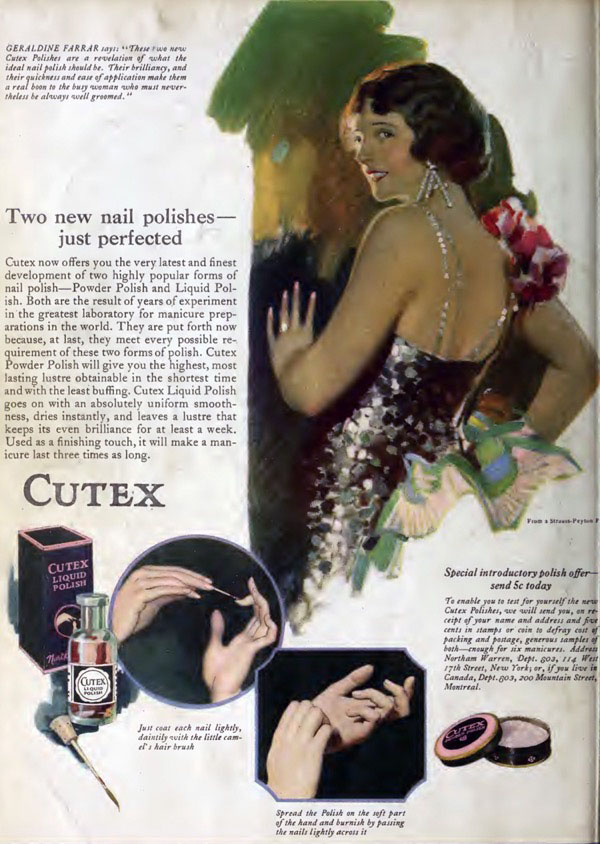
Geraldine Farrar endorses
the new Cutex Polishes, 1919
.
.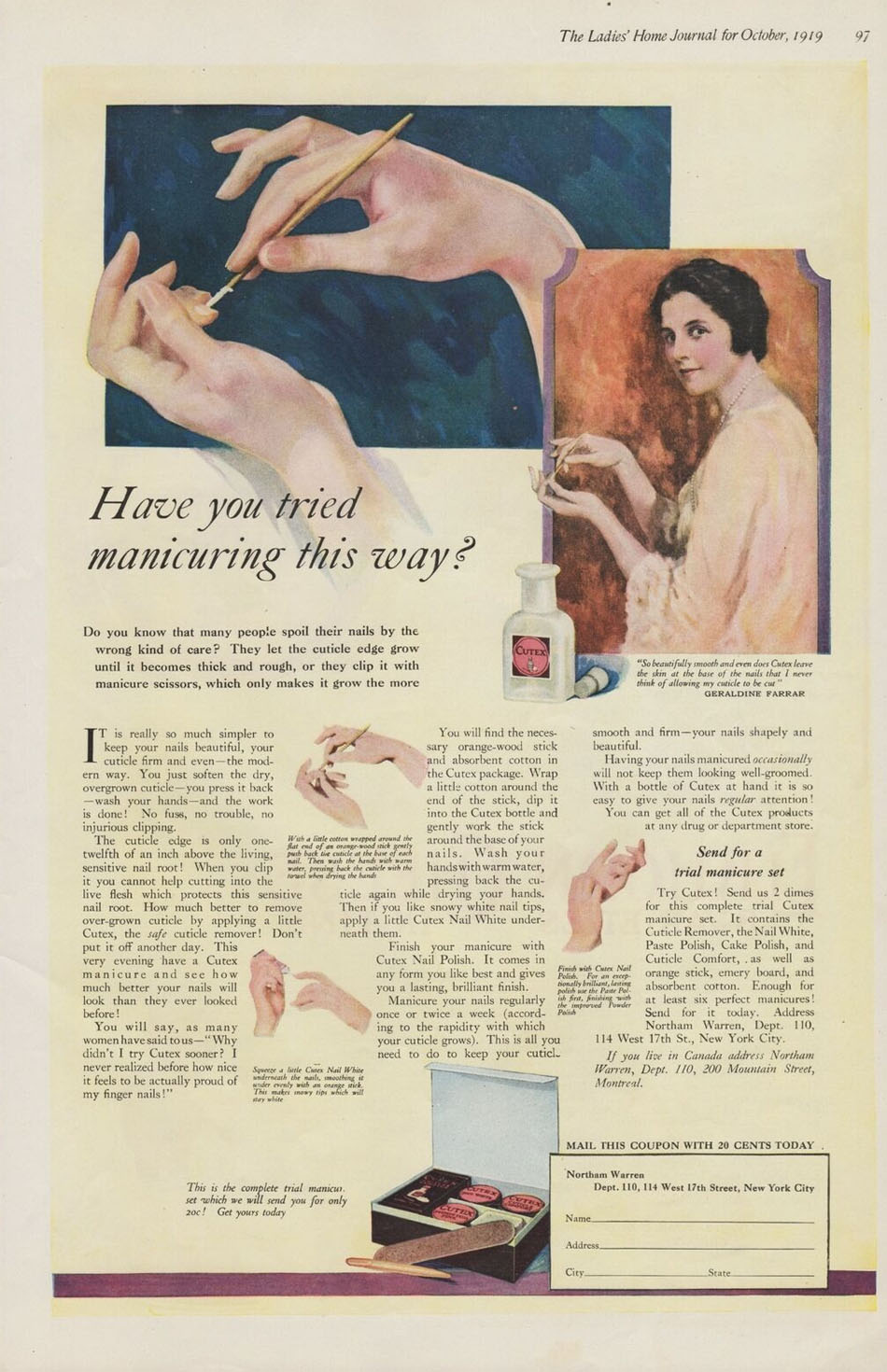
Geraldine Farrar endorses
Cutex, the modern way to manicure, The Ladies' Home Journal,
1919
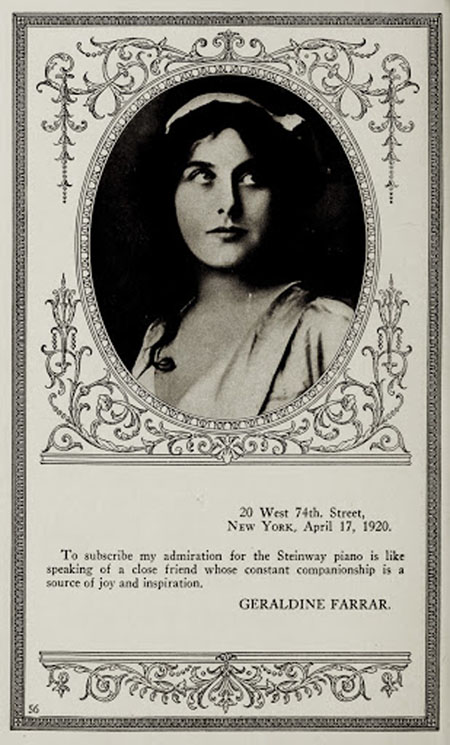
April 17, 1920 Testimonial
by Farrar for Steinway pianos
“The World and Its
Woman” and “The Jewel Song”
Farrar was a prima donna, movie star
and true celebrity of her time. This movie excerpt from “The World
and Its Woman” (1919), starring Geraldine Farrar, is accompanied by
a 1913 Victor recording of Farrar singing Marguerite's aria the "Jewel
Song" from Gounod's Faust. (1 min 33 sec).
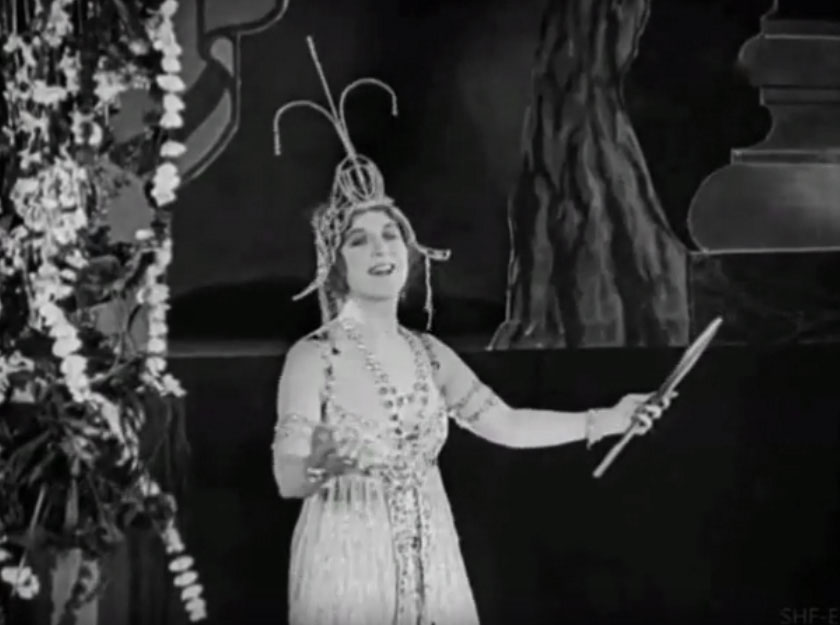
WATCH
Geraldine Farrar as Marguerite singing "The Jewel Song"
in The World and Its Woman, 1919
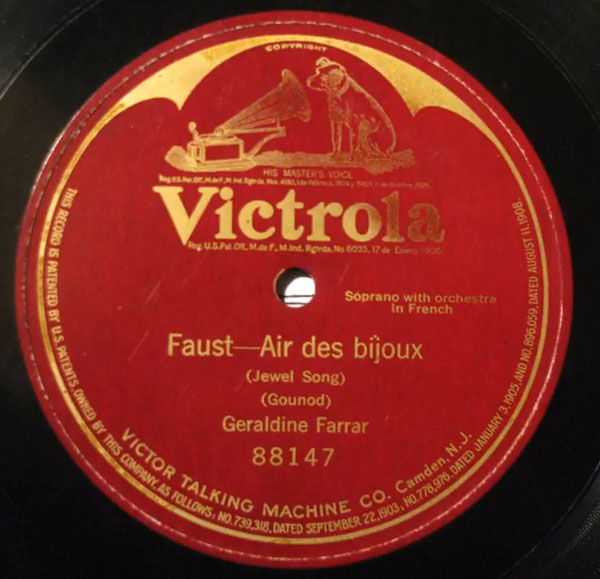
"The Jewel Song"
sung by Geraldine Farrar, Victor Record No. 88147
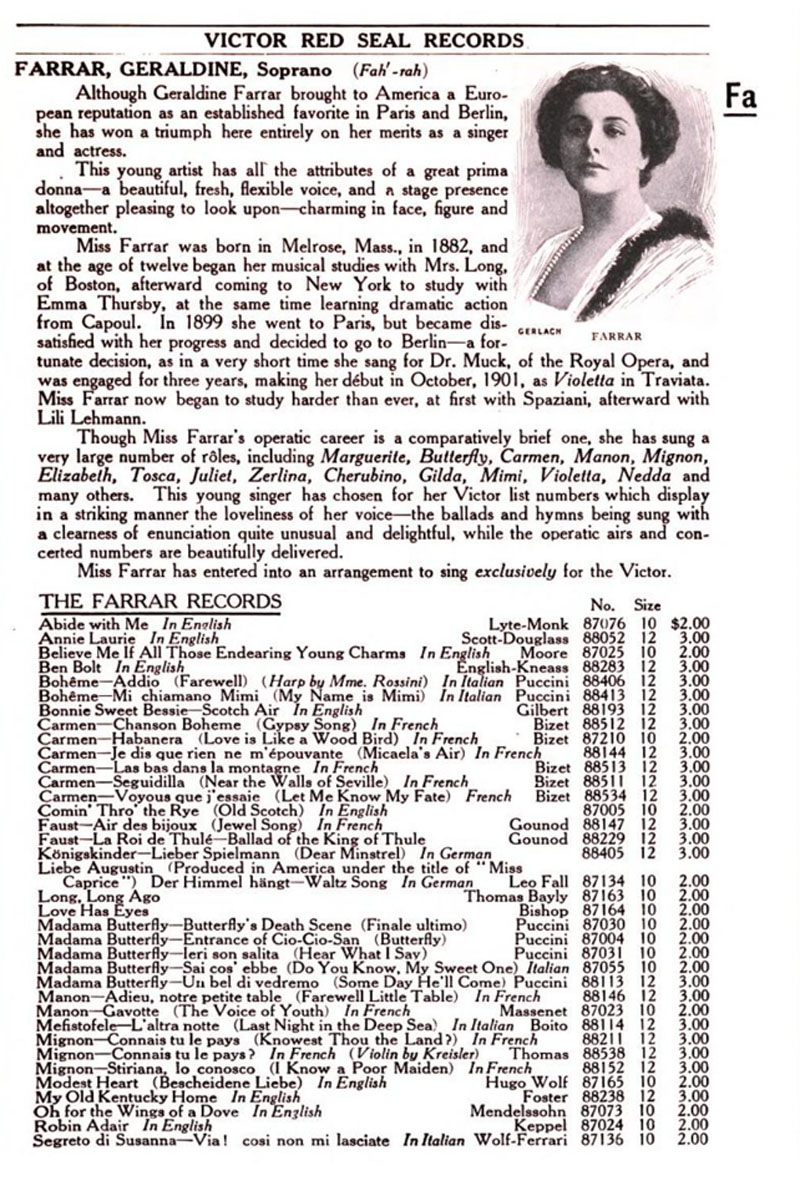
1915 Victor Red Seal
Records which included Geraldine Farrar's "Faust - Air des
bijoux" (Jewel Song) Record No. 88147 for $3.00.
Geraldine Farrar of one
of the Artists who made Records Exclusively for the Victor. From "Victor
Red Seal Records A Library of
Famous Voices" - The Art
of Great Singers and Players Recorded in Imperishable Form for the
Benefit of the Present and Future Generations." Victor
Talking Machine Company, 1915 (digitized by Google Books courtesy
of Indiana University Library).
Geraldine Farrar
and Mme. Schumann-Heink

Farrar and Schuman-Heink,"The
Chosen instrument by the world's greatest artists." The Ladies'
Home Journal" November 1918
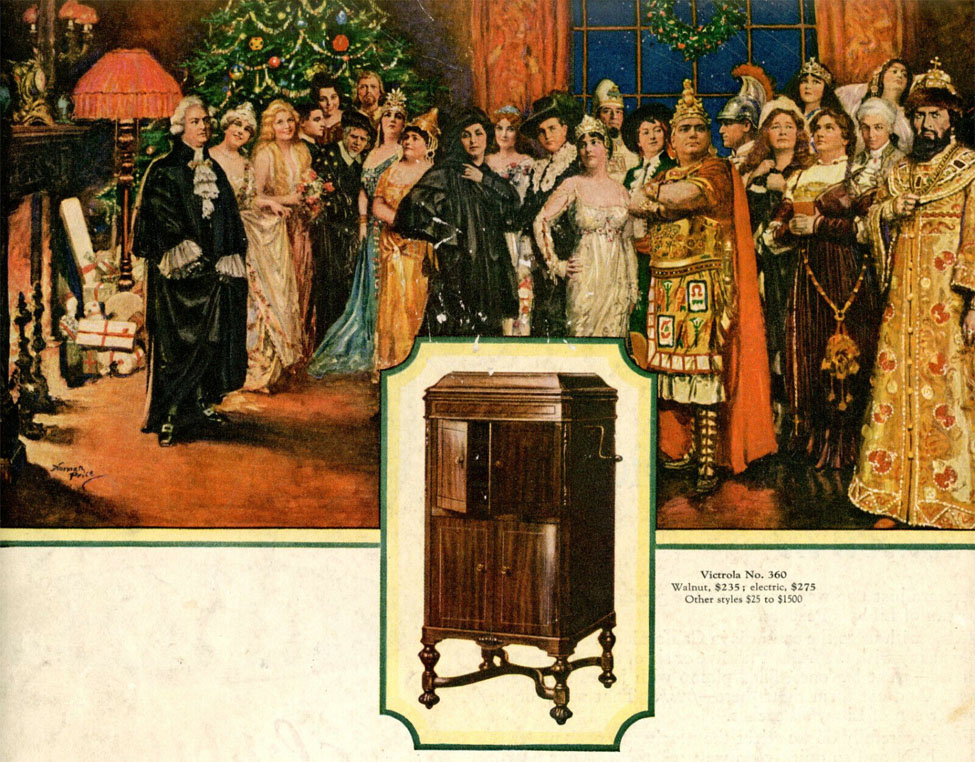
The Victrola No. 360, 1924
Farrar and Schuman-Heink, "The
finest gift of all - The gift that keeps on giving." (Top section
of Victor Christmas ad).
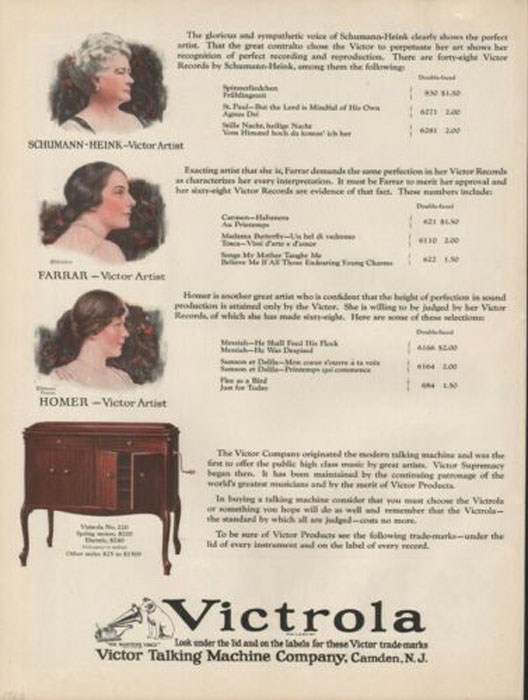
1923 Farrar and Schuman-Heink
and Homer - "Victor Supremacy"
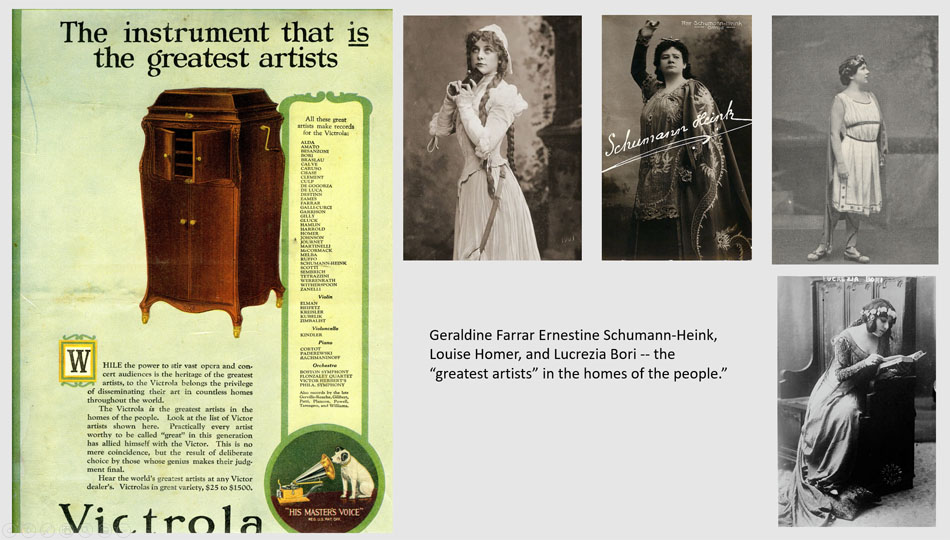
Farrar, Schumann-Heink,
Homer and Bori: "the instrument that is the greatest artists"
in the homes of the people." 1920 (PM-0896)
Geraldine Farrar,
Mme. Schumann-Heink and Mary Garden
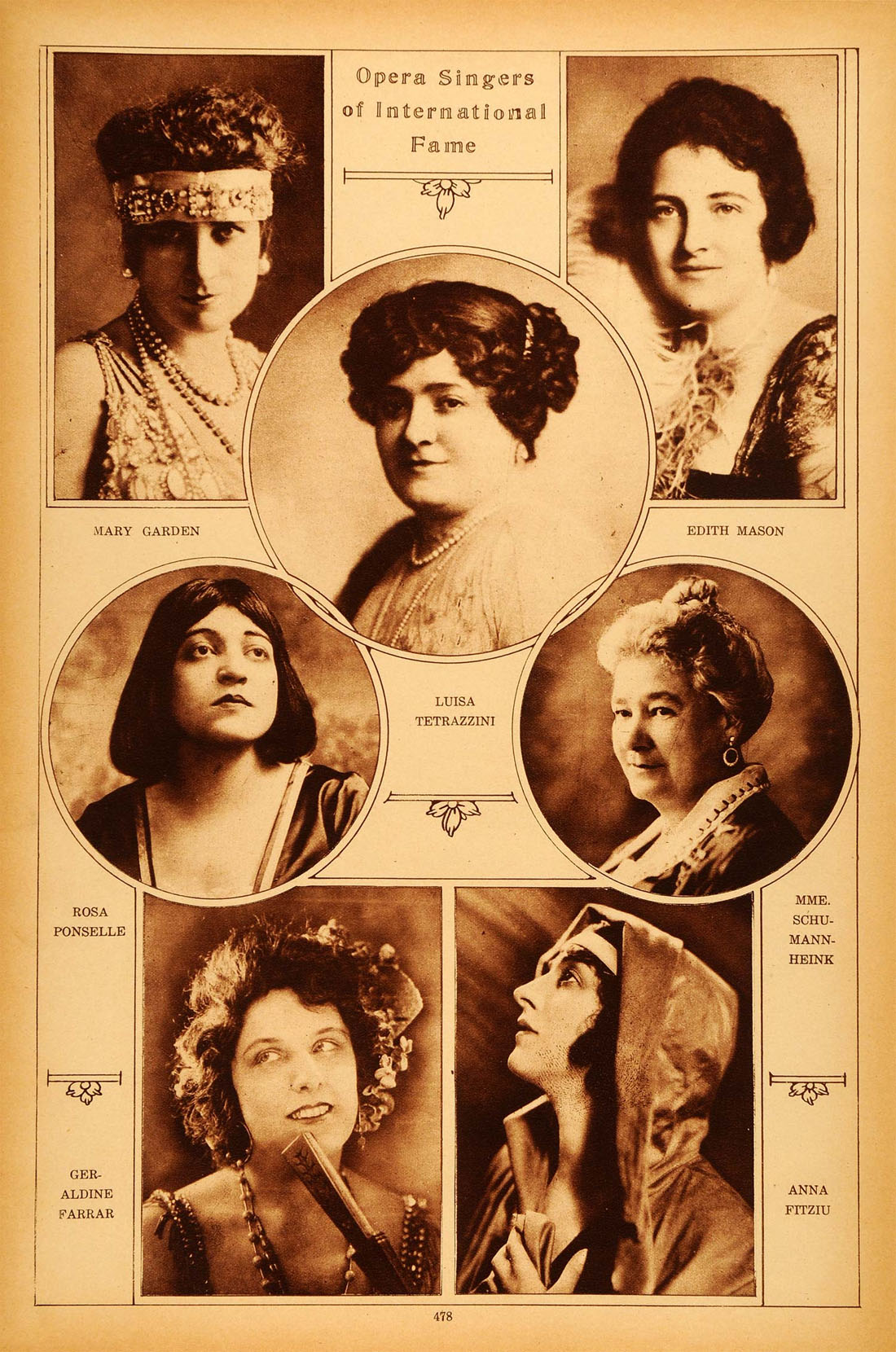
Farrar, Schumann-Heink,
Mary Garden - 1922 sepia rotogravure

Farrar—
That's All A SIMPLE AMERICAN GIRL WHO BREAKS EVERY TRADITION OF
TEMPERAMENT By Morris Gest
(New York theatrical manager responsible for Miss Farrar's debut in
The Movies.) Photoplay Magazine, December 1915.
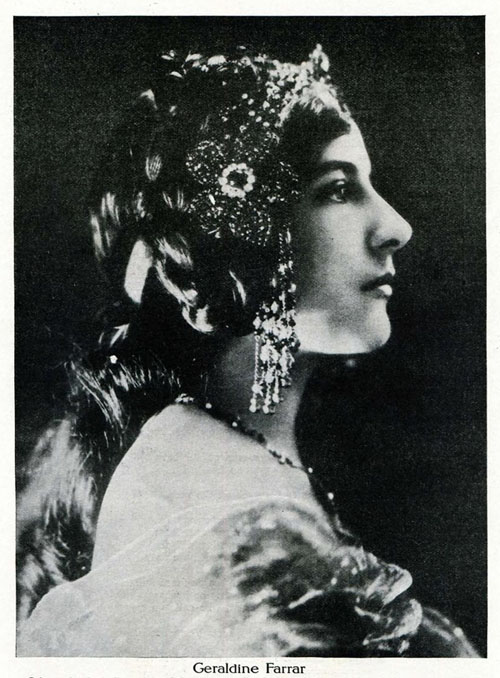
Farrar as Salome, in the lyric
tragedy of that name by Dr. Richard Strauss, composed upon a German
translation of the one-act play by Oscar Wilde. It is interesting
to note that Wilde, an Irish-Londoner, wrote his drama in French,
for Mme. Sarah Bernhardt, with whom it did not find much favor...
"Today at the age of thirty-three Geraldine Farrar is unquestionably
the greatest among the world's singing women." (Source: Farrar,
Ibid., p. 104.)
See the Victor Talking Machine Company's
1921 The
Victrola Book of the Opera published by the Victor Talking
Machine Company for illustrations and records related to Geraldine
Farrar.
Visit the Phonographia gallery Willa
Cather's Prototypes who were Recording Artists for an overview
of Cather's six opera related prototypes: FARRAR, FREMSTAD, NORDICA,
GARDEN, SCHUMANN-HEINK and BORI.
Youth and the Bright Medusa is
also a PhonoLiterature
Book Selection where text from the book and additional phonograph
connections are documented.

Phonographia
|
































































